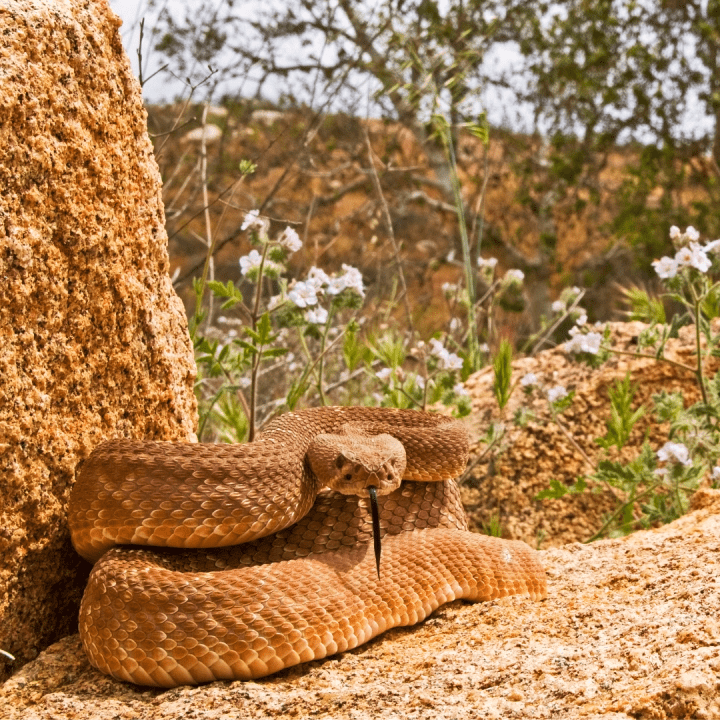When most people see snakes near a hiking trail, they run from them. I am one of those people who say “Snake? Where?” and excitedly run towards them. I have always loved spotting snakes in Southern California (and give them plenty of space) because we have such a great variety of these beautiful and often misunderstood creatures.
There are at least 45 different species and subspecies of snakes that call Southern California home. Some are definitely more common than others, but it is always exciting to see one slither by.
I have put together this guide to snakes in Southern California to help you identify the snakes you discover while exploring SoCal, and give you a little insight into the tremendous diversity we are lucky enough to have.
45 Snakes in Southern California
California Kingsnake
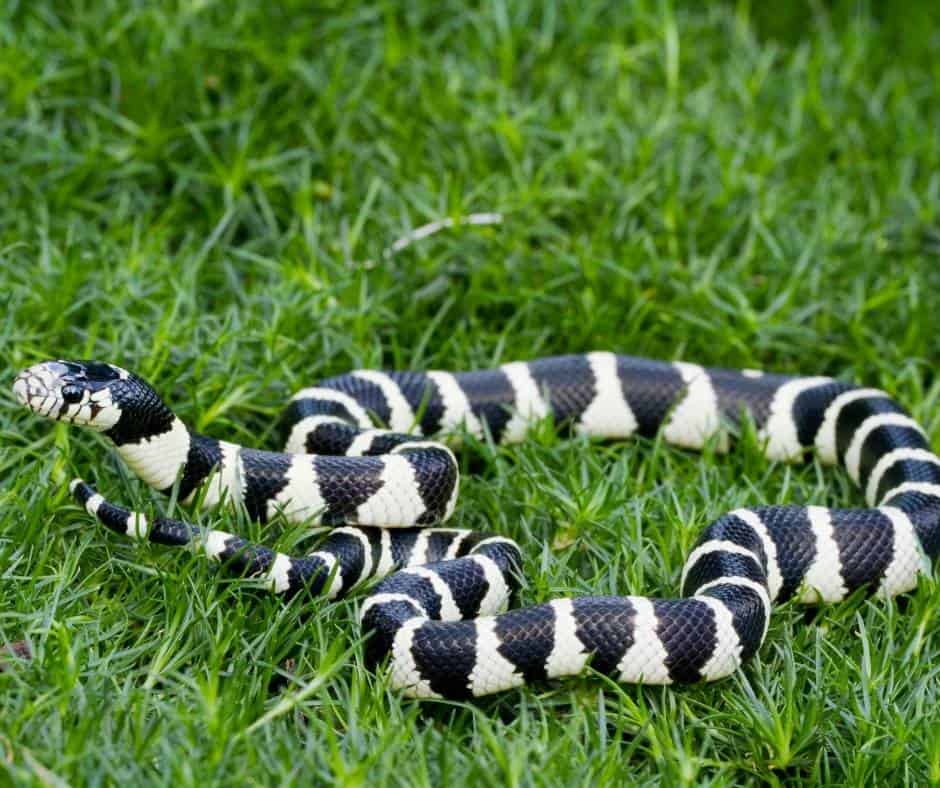
Is a California Kingsnake venomous? No
Where does the California Kingsnake live in Southern California? Kingsnakes live in every county in Southern California. They inhabit a wide variety of landscapes including coastal scrub, woodlands, grasslands, chaparral, and desert scrub.
Kingsnakes are one of the more common species of snake in Southern California. This is in part because they are adaptable to a wide variety of landscapes.

They do come in a variety of colorations, but the most common are dark brown or black in color with whitish yellow bands. They are known as “king” snakes because they eat other snakes, including venomous rattlesnakes! They also eat lizards, birds, and rodents.
Califronia Kingsnakes are slender but they can grow about 2.5 – 4 feet in length. They weigh about 3lbs.
Learn more about Southern California wildlife. Here is your guide to all the hawks in Southern California.
Coast Mountain Kingsnake

Is a Coast Mountain Kingsnake venomous? No
Where does the Coast Mountain Kingsnake live in Southern California? Mountain areas across Southern California, especially closer to the coast, but as far east as the San Bernardino Mountains.
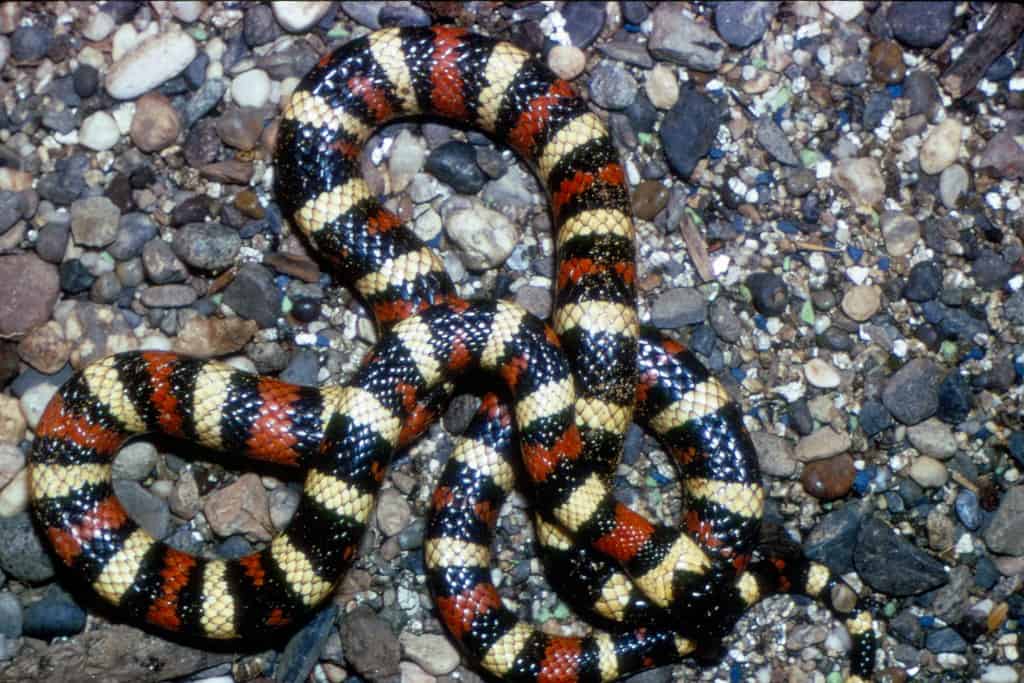
The California Mountain Kingsnake is one of the most beautiful snakes in Southern California. It has repeating bands of reddish orange, black, and off white. This distinct coloring makes them easy to identify. They are generally 2-3 feet long and slender.
Their diet is similar to that of the California Kingsnake- primarily reptiles, birds, and rodents. They live in oak and pine woodlands, chaparral and coastal sage srub, and wooded areas near water.
Southern Pacific Rattlesnake

Is the Southern Pacific Rattlesnake venomous? Yes! If you are bit seek medical treatment immediately.
Where does the Southern Pacific Rattlesnake live in Southern California? This rattlesnake lives in every county of Southern California except Imperial County. It can be found in nearly all of Santa Barbara, Ventura, LA, Orange, and San Diego counties. It is also in the western third of Riverside County and southwestern corner of San Bernardino County.
The Southern Pacific Rattlesnake is the subspecies of Western Rattlesnake that is most commonly seen in Southern California. It is the snake I most commonly see when I am out hiking in Orange County. You are most likely to see them sunning themselves in the spring and fall.
They often see you before you see them and will give you fair warning with a rattle of their tale. They are not aggressive but they are venomous, so steer clear and give them plenty of space if you are passing by.

Many people tend to think that the rattlesnakes they seeing in the LA/OC/SD area are Western Diamondback Rattlesnakes, but those snakes do not live in this area. If you see a rattler near these heavily populated urban and suburban areas, it is very likely a Southern Pacific Rattlesnake.
They live in a variety of Southern California landscapes such as chaparral, rocky areas, and grassy areas. I have seen them most often near rocks sunning themselves or in dry grass near the edges of trails.
These snakes are anywhere from 1-5 feet long, and have a stripe behind the eye extending behind the corner of the mouth. They have the triangular head that is common with all pit vipers.
Southern Pacific Rattlesnakes have rattles at the end of their tales, but young rattlers may only have a single rattle. Their tails are more stumpy than a Gopher Snake (which can look similar). Gopher Snakes have tails that taper and become quite skinny at the end.
They do have light and dark rings at the tail but they aren’t sharply contrasting like the Western Diamondback and Northern Mojave Rattlesnake. There is a thicker tail ring right before the rattle that is generally dark brown in color.
Fun fact: A new rattle is gained each time the snake sheds it skin!
Their coloring varies in shades of medium brown to a darker olive brown. They have bloches going down the length of their body which are outlined by a light brown/offwhite color. Their undersides are typically pale in color.
These snakes eat lizards; small mammals like mice, rabbits, and ground squirrels; amphibians; birds; and even other snakes!
They are often ambush predators but they will also chase a critter when they are on the move. Since they are pit vipers, they have pits on the side of their heads that sense heat and help them target prey.
There are over 25 varieties of snakes in Joshua Tree National Park, including the Southern Pacific Rattlesnake. Use our Joshua Tree Day Trip Itinerary and keep your eyes out while exploring.
Western Diamondback Rattlesnake

Is a Western Diamondback Rattlesnake venomous? Yes! Immediately seek out anti-venom at a hospital if bit.
Where does the Western Diamondback Rattlesnake live in Southern California? This rattlesnake is found in most of Imperial County and the eastern half of Riverside County in the Colorado desert. If you spend time at the Colorado River, you just may encounter this snake.
The Western Diamondback Rattlesnake is a beautiful rattlesnake, highly regarded in Western lore.
These are big snakes, generally 3-5 feet in length, but some have been recorded at up to seven feet long! This is the largest rattlesnake in the state.
Western Diamondbacks are not agressive towards humans and will only attack as a defensive measure. Most bites occur when people are messing with these snakes or not paying attention to wear they are walking and step near them. They can strike withing one-third of their body length, so give them space!
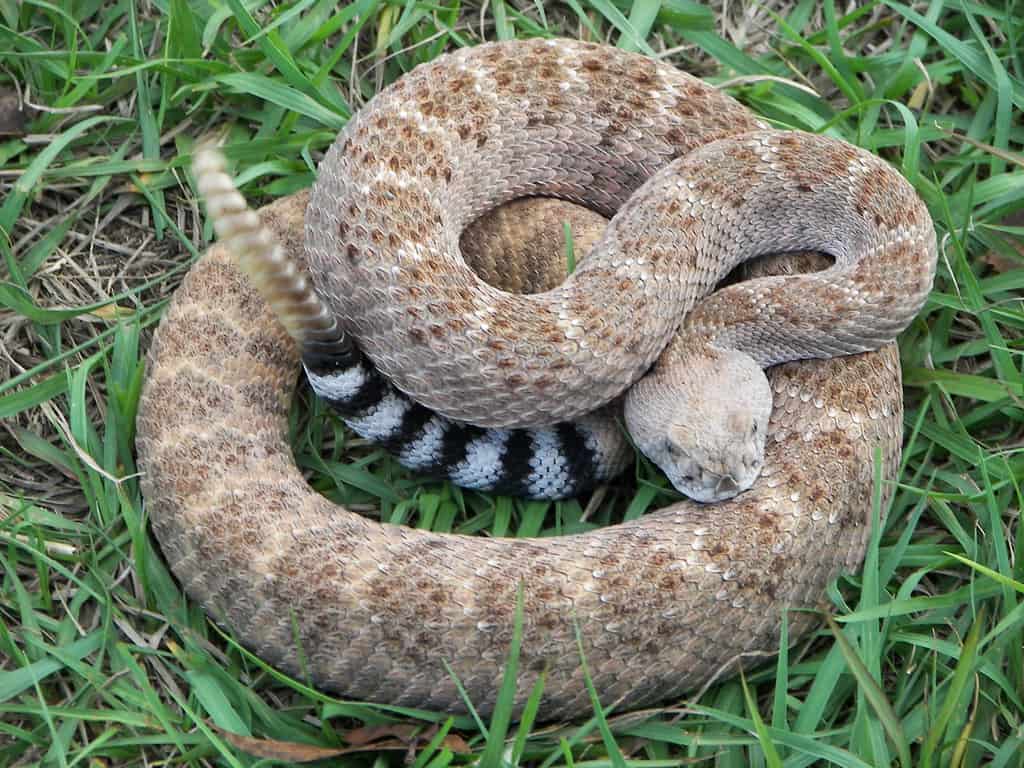
It has the triangular head common to pit vipers, and a thick body. It is most easily identified by the black and white bands evenly spaced on its tail just before the rattle and the diamond pattern on its back.
They come in a variety of shades of brown, olive, and tan that tend to reflect their habitat and help them camouflage.
They eat a variety of small mammals such as mice, kangaroo rats, and jackrabbits. They also will eat lizards and birds. They have pits on the side of their heads that sense heat and help them target prey.
Fun fact: Rattlesnake rattles are made of keratin, which is the same protein that makes up our fingernails and a rhino’s horn. Pieces of rattles can get damaged or break off, but it is painless.
Northern Mojave Rattlesnake

Is the Northern Mojave Rattlesnake venomous? Yes! This is the most venomous snake in the state. Seek urgent medical treatment immediately if bit.
Where does the Northern Mojave Rattlesnake live in Southern California? They are found in the Mojave Desert which makes up most of San Bernardino County as well as the Antelope Valley in LA County and eastern Kern County.
In many ways, the Northern Mojave Rattlesnake looks and acts like a Western Diamondback, but there are some differences in appearance.
The most easy way to differientiate the two is location, location, location. Northern Mojave Rattlesnakes live in the high desert while Western Diamondbacks live in Southern California’s low desert.
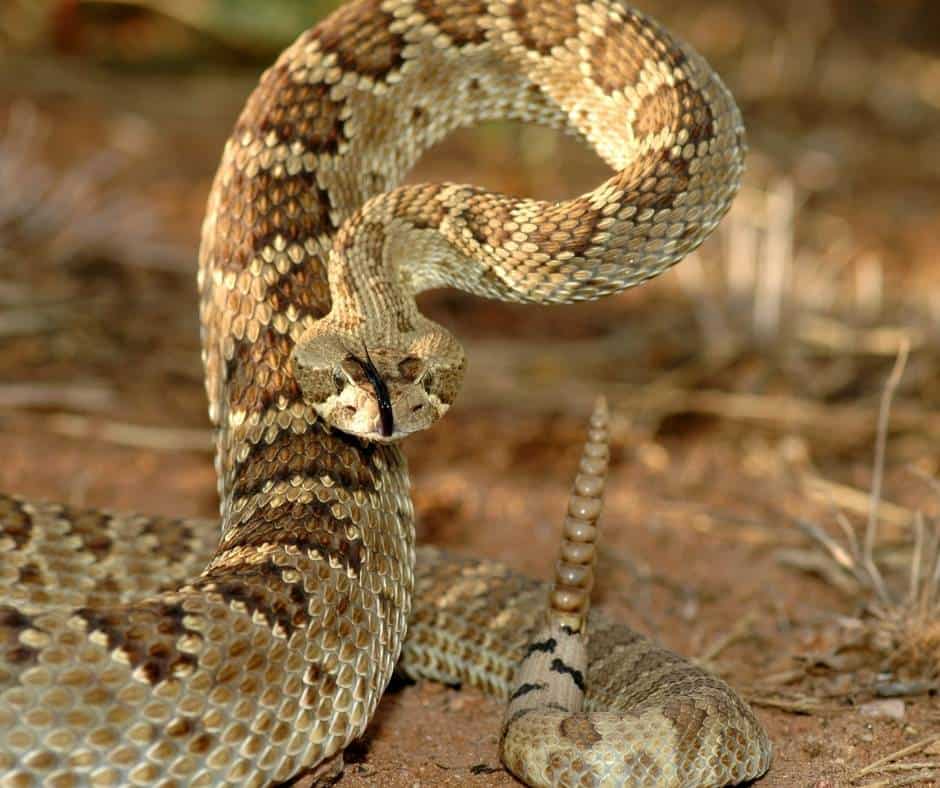
These snakes really do come in a variety of colors, from an almost black/dark brown color to a greenish tinge to a very light tan.
They have a well-defined diamond pattern going along their back and black and white rings near the rattle like a Western Diamondback, but the black rings are narrower than the white rings in this rattler.
The light band that extends from its eye towards its jaw is not as long as the Diamondbacks and does not cross the lip.
This rattlesnake feeds primarily on small mammals (mice, rats, rabbits, gophers), but will eat lizards and amphibians as well.
Southwestern Speckled Rattlesnake

Is a Southwestern Speckled Rattlesnake venomous? Yes! All rattlesnakes are venomous.
Where does the Southwestern Speckled Rattlesnake live in Southern California? The Santa Ana mountains in eastern Orange County, most of San Diego County (except the coastal area), eastern Imperial County, most of Riverside County, most of the southern half of San Bernardino County, and the Antelope Valley.
Speckled Rattlesnakes are most often spotted in rocky areas and they come in a variety of colors that camouflage well with their rocky homes.
If the rocks are light, the snake will be light in color with darker speckled bandings across its back. If the rocks are darker, the snakes will be darker brown with dark speckled bandings.

These snakes can be a light salmon color, gray, muted browns and even almost off white with speckles. Adult Speckled Rattlesnakes are typically 2-3.5 feet in length. They do have black and white (or off white) rings near the end of their tail at the rattle, similar to a Diamondback.
They are pit vipers with pits on the sides of their triangular heads used to detect heat and identify prey. They are primarily ambush predators who eat small mammals, reptiles, and small birds.
Red Diamond Rattlesnake
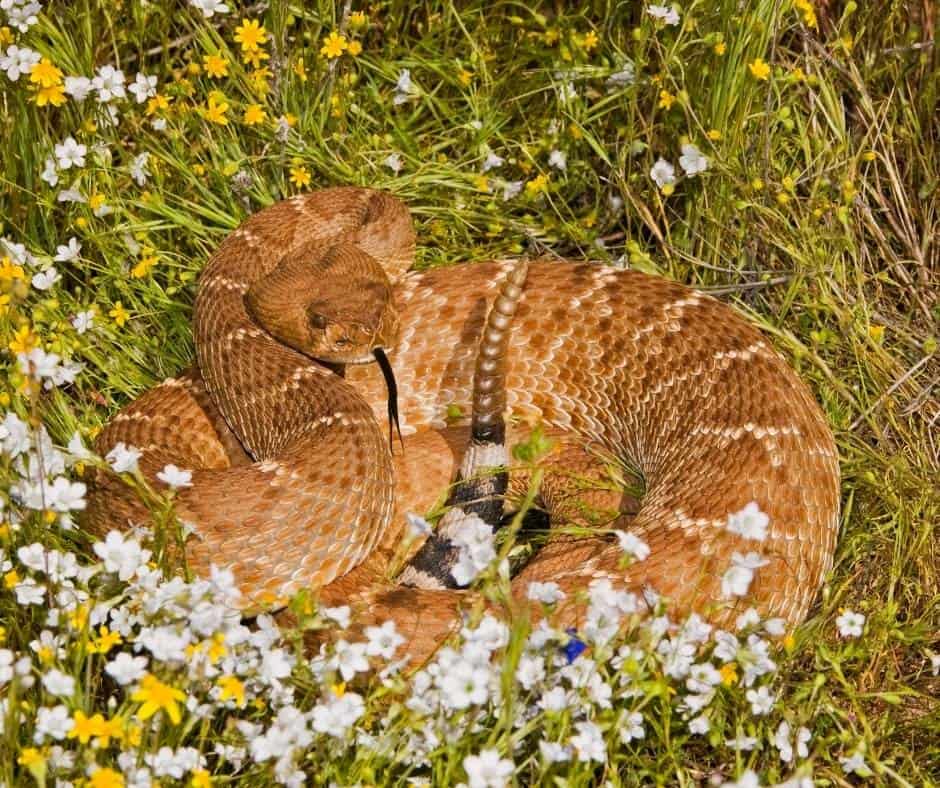
Is the Red Diamond Rattlesnake venomous? Yep!
Where does the Red Diamond Rattlesnake live in Southern California? It mainly lives in San Diego County, Orange County, and western Riverside County.
The Red Diamond Rattlesnake is another beautiful rattler in Southern California. It lives in the southernmost reaches of the state, mostly in coastal areas, chaparral, and rocky, scrubby mountain areas.

It can be reddish, pink, or tan with a red tinge. It does have a faint diamond pattern and the black and white rings near the rattle that are common among many rattlesnakes in Southern California. It is easiest to identify this snake because of its rusty or ruddy red coloring.
The Red Diamond Rattlesnake is 2-5 feet long and has those trademark rattlesnake pits on the sides of their triangular heads used to detect heat and identify prey. They eat small mammals, lizards, and birds .
Fun fact: A rattlesnake shakes its rattle 60 time per second. That’s fast!
Two-Striped Garter Snake
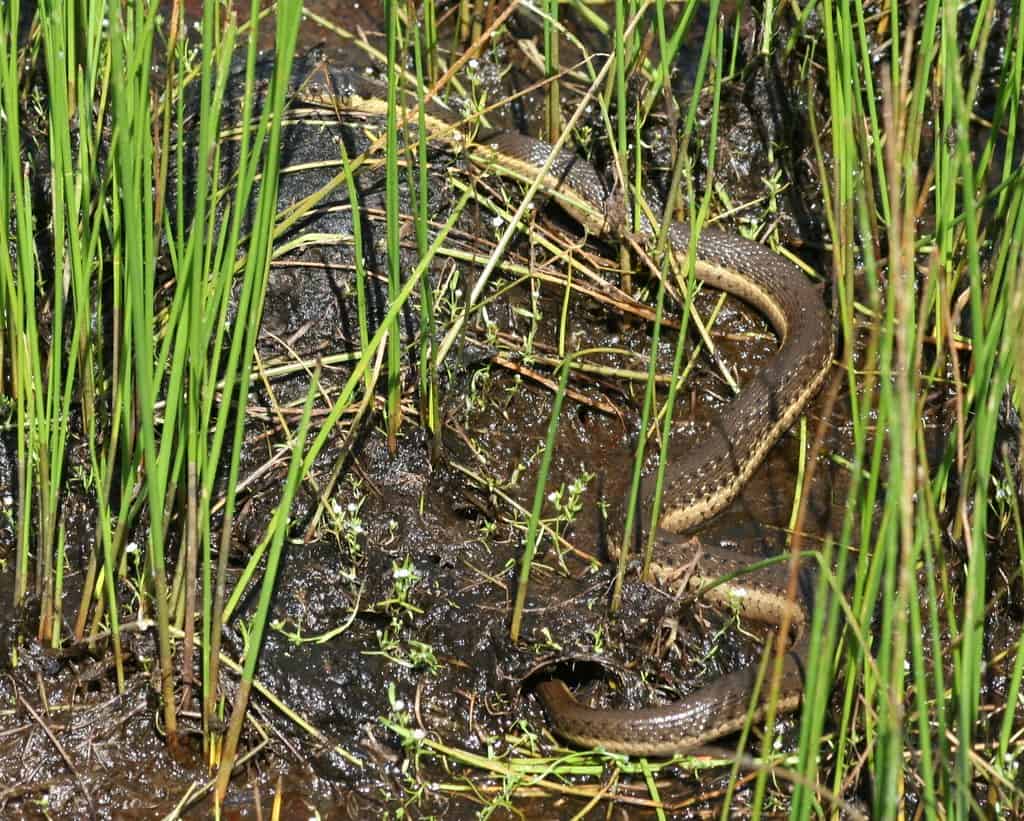
Is a Two-striped Garter Snake venomous? No
Where does the Two-Striped Garter Snake live in Southern California? In all of the coastal Southern California counties, as well as far western Riverside and San Diego counties.
The Two-striped Garter Snake is one of the snakes that calls Southern California’s freshwater waterways home. It is an aquatic snake that is usually spotted swimming across creeks, streams, and rivers.
Some of my favorite childhood memories were of catching Garter Snakes in my aunt’s backyard, running up behind my relatives to scare them with the snake, and then releasing them by her pond to watch them peacfully glide across the water.
This snake eats fish, and will grab a fish out of the water and then drag it to the shore to eat. It is quite a sight to see! The Two-striped Garter Snake also eats things that live along the water like frogs and worms.

This snake is not venomous or agressive towards humans. It is usually 2-3 feet long and is identified by two lateral stripes along the sides of the snake that are either yellow or gray.
Some are spotted with small dark spots on each side. They are usually darker in color- dark brown, olive gray, or almost black. They are usually pale yellow underneath.
Mountain Garter Snake
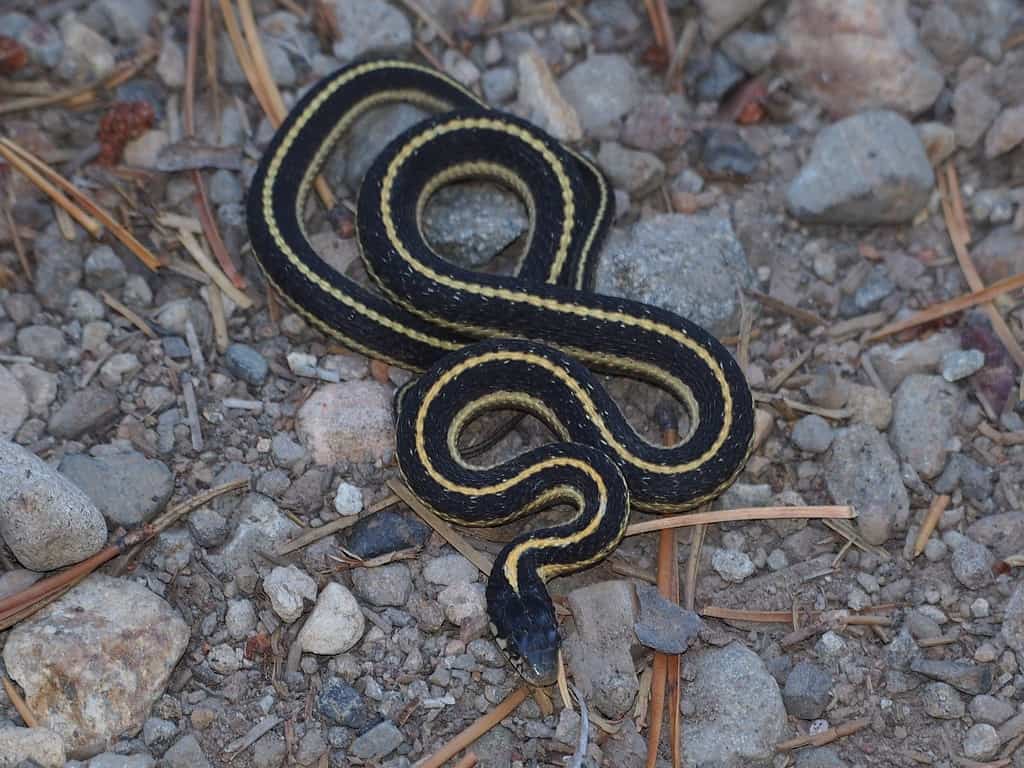
Is a Mountain Garter Snake venomous? No
Where does the Mountain Garter Snake live in Southern California? This species is only found in the San Bernardino Mountains in Southern California. Look for it in the areas around Big Bear.
The Mountain Garter Snake is quite common throughout much of Northern California but there is one isolated population in the San Bernardino Mountains.
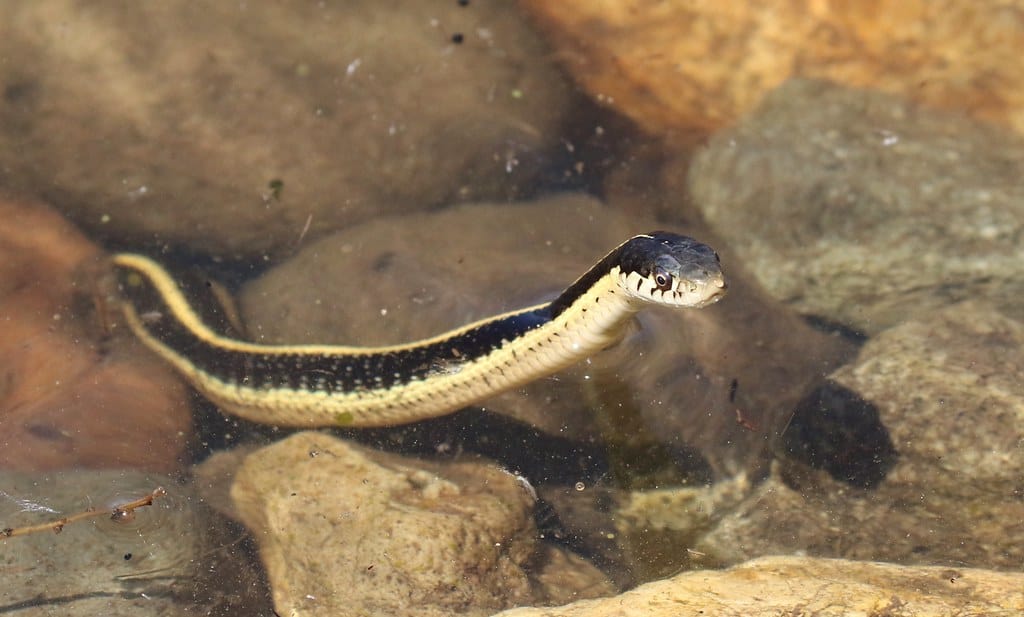
The population in Southern California is generally black with yellow stripes on either side of the body and one yellow stripe along the top of the snake’s back. It is usually a light yellow underneath.
Sometimes they will have thin yellow stripes among the black of their body running perpindicular their body length and almost look like speckling.
This snake is slender and the head is about the same width as the body. It is typically 2-4 feet in length. They tend to hang out near water like creeks and streams where they can feast on the critters that live in or near the water.
These snakes will eat a wide variety of creatures that live in and around the water including fish, frogs, leeches, slugs, lizards, and mice.
Marcy’s Checkered Garter Snake
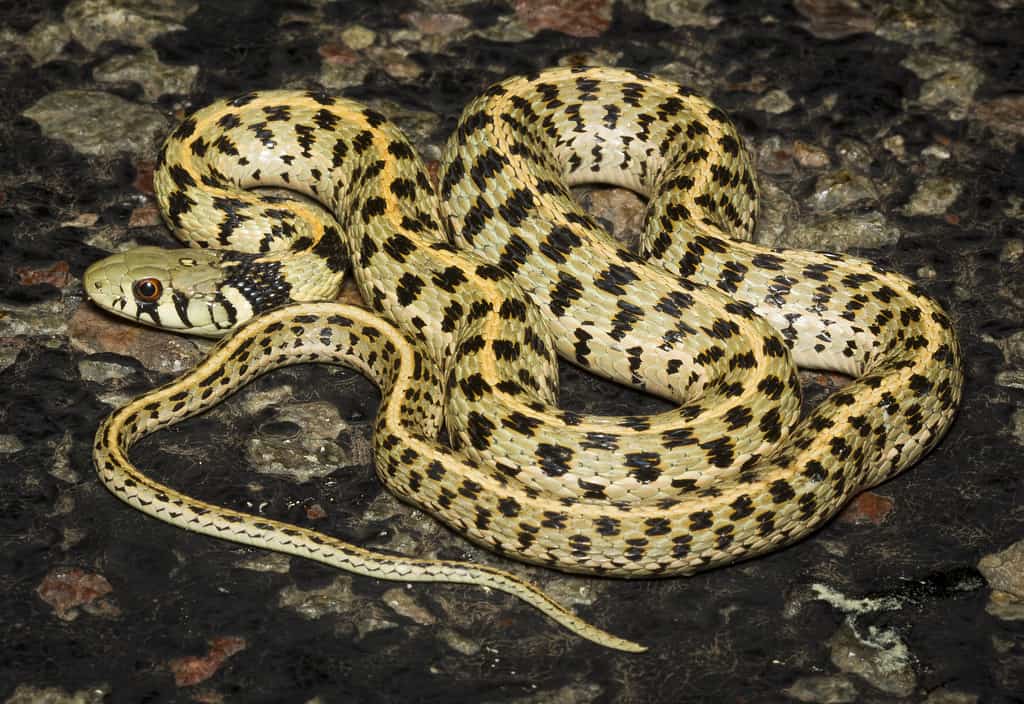
Is Marcy’s Checkered Garter Snake venomous? No
Where does the Marcy’s Checkered Garter Snake live in Southern Cailfornia? In agricultural waterways in Imperial County and the portion of SoCal runs along the Colorado River. It also can be found in the area around the Salton Sea.
The Marcy’s Checkered Garter Snake is not seen in most of Southern California, but if you head out to the Colorado River to camp and play, you just might see one. It is an aquatic snake so be sure to watch for it in the water and safe places to hide along the shore.
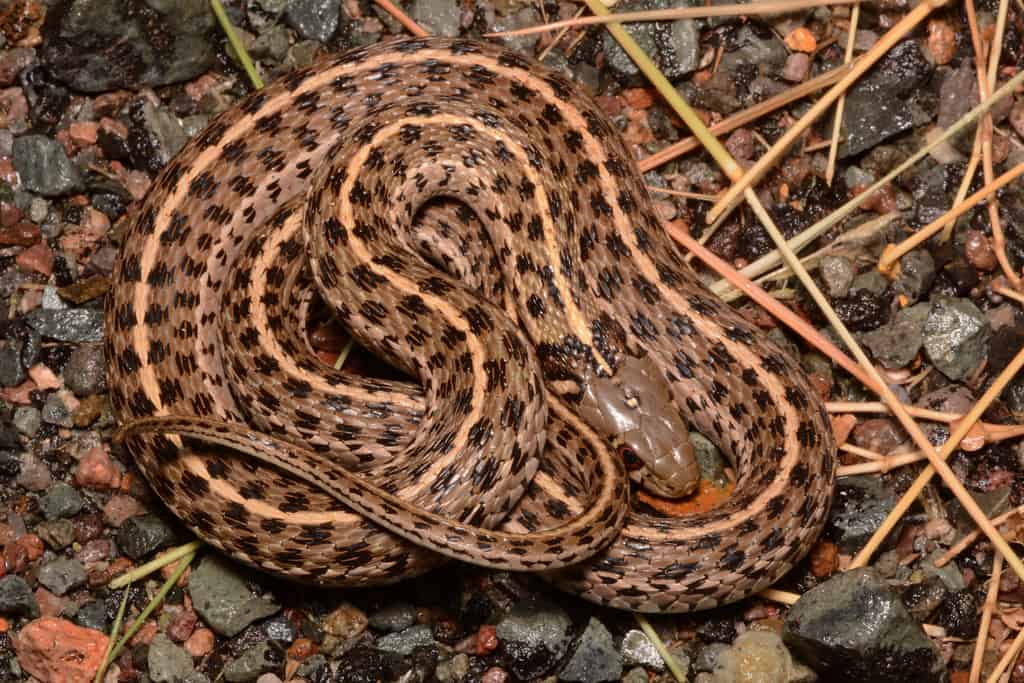
A Marcy’s Checkered Garter Snake is typically 2-3 feet long and has the yellow stripes on its back and sides that are typical of many garter snakes, but this snake has a checkerboard pattern of black splotches going along its back as well. It is usually tan or brown. It is light colored (pale yellow or off white) underneath.
The checkering does throw some people off and make them think it is not a harmless garter snake, but rest assured that these beauties aren’t venomous.
As with most garter snakes, Marcy’s Checkered Gater Snakes eat lots of amphibians and fish, but they will also eat lizards, small mammals, and even small snakes if given the chance.
Fun Fact: When Garter Snakes are picked up or disturbed they often empty the contents of the cloaca or produce a musk.
Common Garter Snake
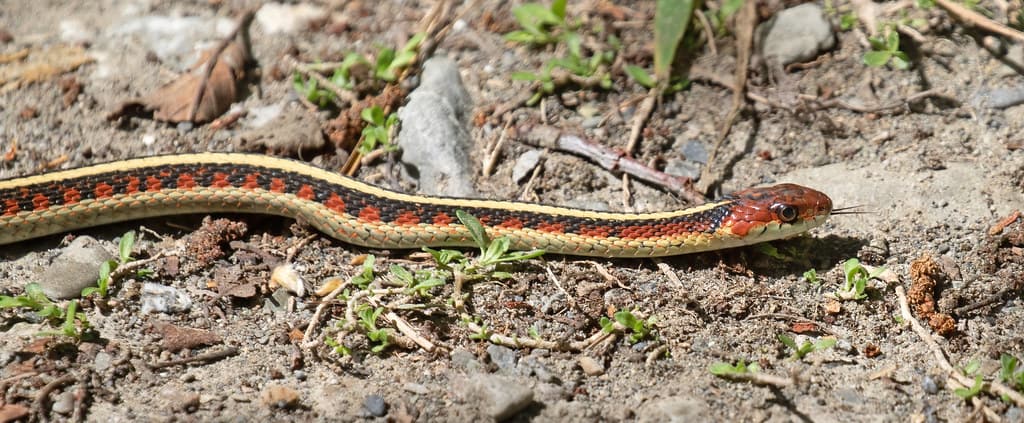
Is the Common Garter Snake venomous? Nope
Where does the Common Garter Snake live in Southern California? In regions close to the coast in Santa Barbara, Ventura, Los Angeles, Orange, and San Diego Counties as well as the far western portions of San Bernardino and Riverside Counties. It’s territory extends north into much of Central and Northern California.
There are two subspecies of the Common Garter Snake that call Southern California home. They are the California Red-sided Garter Snake and the Valley Garter Snake. The best way to tell them apart is to base it on geographic location.
The Valley Garter Snake is found in the the northern half of Ventura County and points northeast. The California Red-sided Garter Snake occupies occupies points south. It may also be found along the coast in Santa Barbara County and into Central California.
Both subspecies live in a variety of habitats, but usually near water like ponds, creeks, and marshes. They can be found near the ocean, in chaparral, in grasslands, farmlands, and wooded areas.
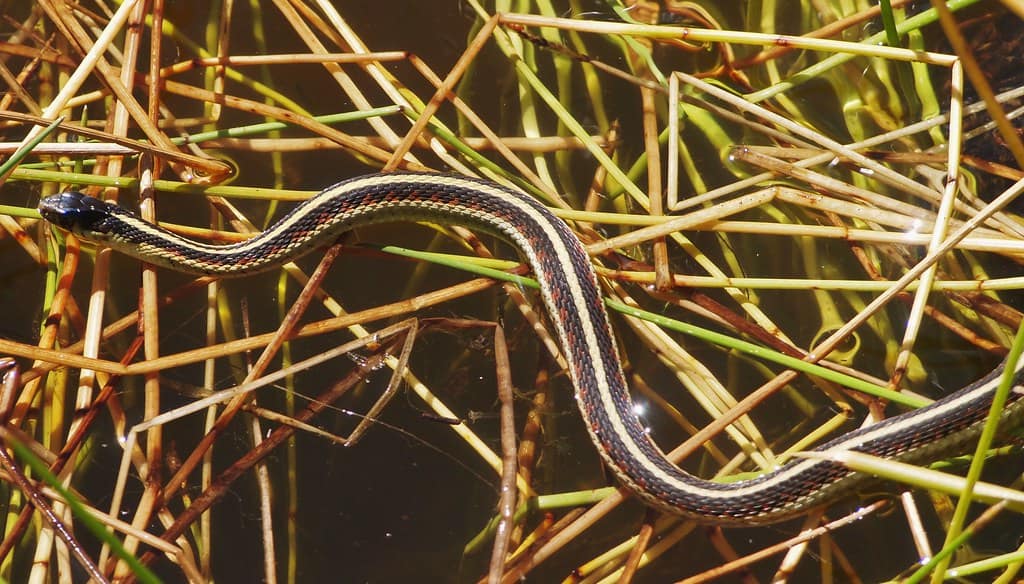
These snakes have the long, pale, yellow stripes on the top and lower side of their bodies that are common to garter snakes, but they also have red bars alternating in color with the body color running along either side of length of their bodies.
The body of these snakes tends to be a dark olive brown to black in color. It is usually about 3 feet long but can grow up to 4 1/2 feet in length. Heads are about the same width as bodies. They are a pale yellow to off white color underneath.
Like most garter snakes, they eat things that live near water like frogs, slugs, newts, small mammals, and fish.
Fun fact: There are some varieties of California Red-sided Garter Snakes that have aqua bluish stipes in places of the yellow. They are also aqua blue on their undersides!
Gopher Snake

Is a Gopher Snake venomous? No
Where Does the Gopher Snake live in Southern California? Gopher Snakes live all over Southern California. They are a very common snake and one of the snakes you are most likely to see in Southern California. There are four subspecies of Gopher Snake in SoCal which I will list below.
Gopher Snakes can be quite large and range in size from 2.5 feet to 9 feet long! They are daytime hunters which also increases the likelihood that you might spot one.
They are often confused with rattlesnakes because they can have similar coloring and size but there are a couple easy ways to tell them apart:
- Gopher Snakes don’t have rattles
- Gopher Snakes have tails that taper and go to a point. Even young rattlesnakes with just a single rattle have stumpy tails.
- Gopher Snakes have faces that are only slightly wider than their necks. Rattlesnakes have wide, triangular faces which are much wider than their necks.
Gopher Snakes are constrictors and kill their prey by striking and then squeezing them to death. They tend to eat small mammals like mice, rats, rabbits, gophers, and squirrels. They will also climb trees and get into birds nests. They eat lizards and insects when the pickings are slim.
They live in a wide variety of habitats including chaparral and coastal scrub, grasslands, woodlands, deserts, near water, in agricultural areas, in mountains, and canyons. Basically, they live all over Southern California.

The Pacific Gopher Snake lives in northern Santa Barbara County and points north throughout California.
Their main body color tends to be a tan to almost a pale brown-yellow. They have large dark brown splotches down their backs and smaller spots on the sides. The top of the head is usually brown. Eyes are typically brown, amber, or red.
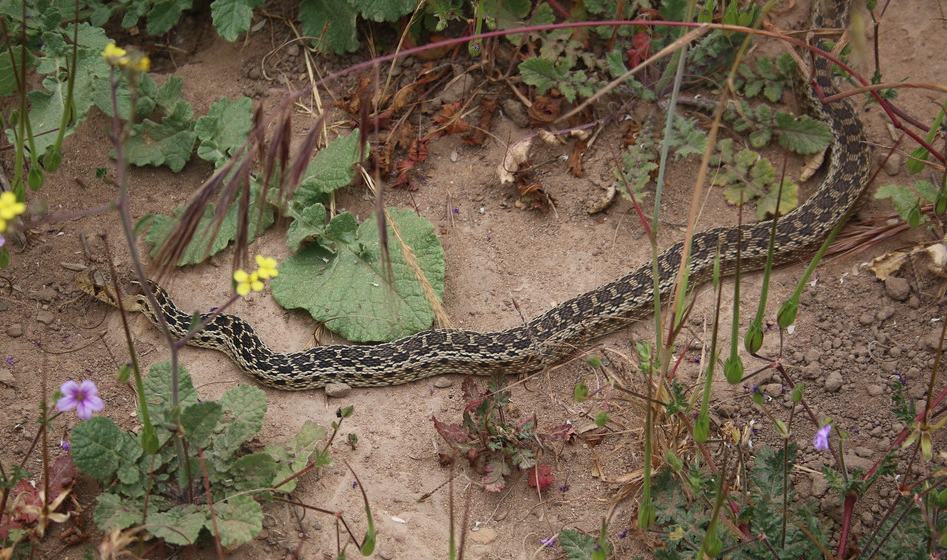
The San Diego Gopher Snake lives in coastal Southern California. Its range is as far north as coastal San Louis Obispo County all the way down to its namesake of San Diego. It includes most of Santa Barbara, Ventura, and LA Counties as well as all of Orange County, the western third of Riverside County, and the southwest corner of San Berardino County.
Like the Pacific Gopher Snake its body tends to range from light brown to yellowish. It also has the dark brown splotches down its back and smaller spots on the sides. The underside is a similar light color as well.
However, these snakes tend to darker (brown to even orange) on the top of their heads and some even have the orange down by the base of their tail and along portions of their back.
Others might not have much orange at all and look almost identical to Pacific Gopher Snakes. There are even varieties without spots! Gopher Snakes tend to have lots of exceptions to their identification rules so I tend to go by location when determining the subspecies.
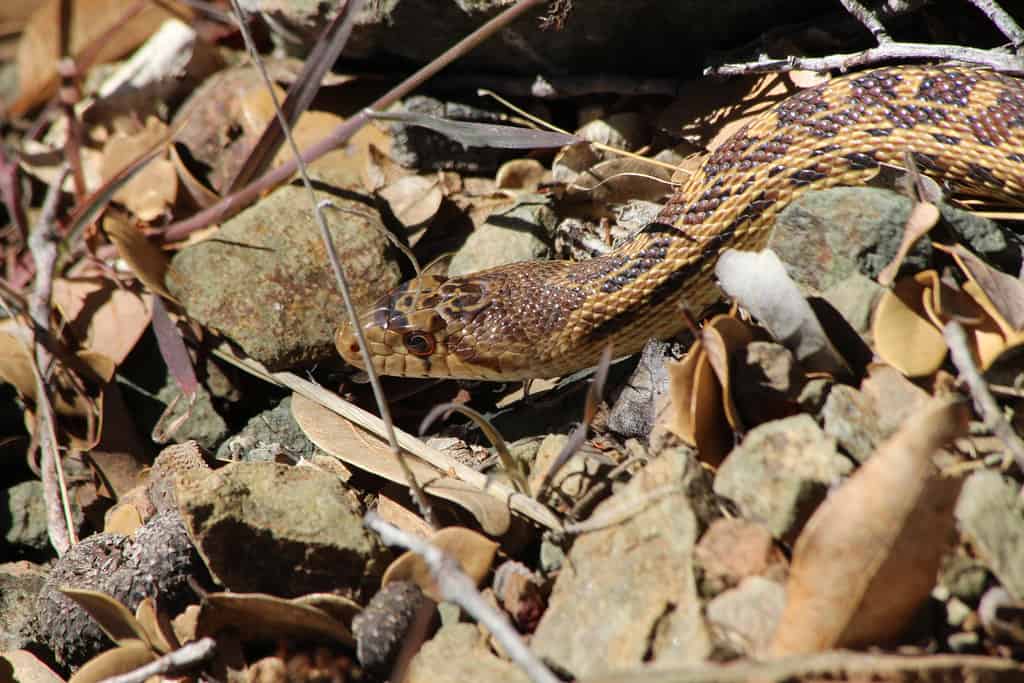
The Sonoran Gopher Snake lives in all of Imperial County and the easter 2/3 of Riverside County. It also lives in the small sliver of San Bernardino County that borders Arizona.
These snakes have light tan to straw colored bodies with the large brown splotches down their back and smaller spots on their sides. Their undersides are a light color.
The main way to differentiate them from Pacific Gopher Snakes (other than geographical location) is that the top of their heads are a light tan with little dark spots.
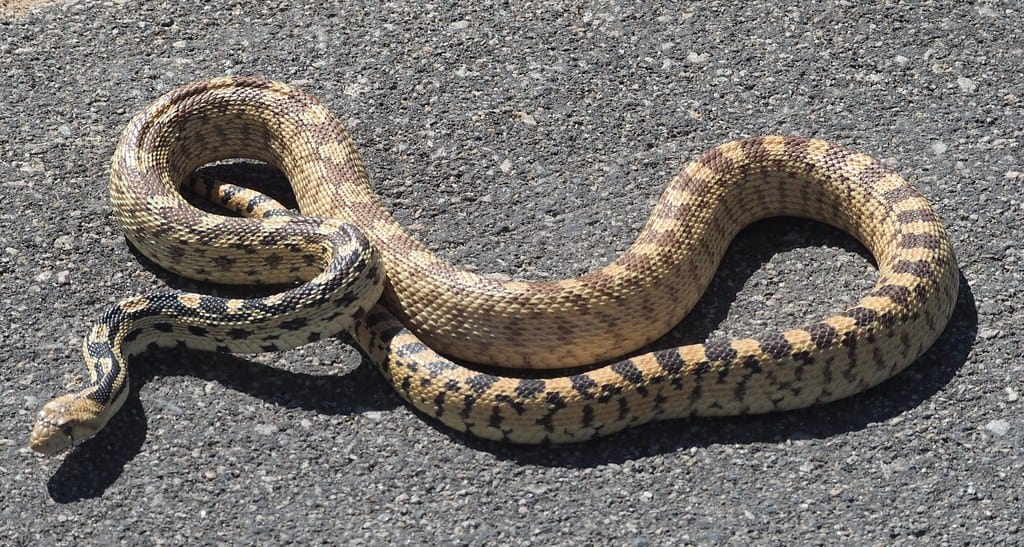
Finally, the Great Basin Gopher Snake lives in most of San Bernardino County (unless otherwise mentioned) and the Antelope Valley of LA County. Its range continues up toward Death Valley in Inyo County.
Once again they have the light cream to yellowish tan bodies, splotches down their back (brown, sepia, or even reddish) and small spots on their side.
The big splotches tend to be darker at the head and neck and lighter mid body. Their heads are typically close to the same color as their bodies. Undersides are light colored with dark marks.
Rosy Boa
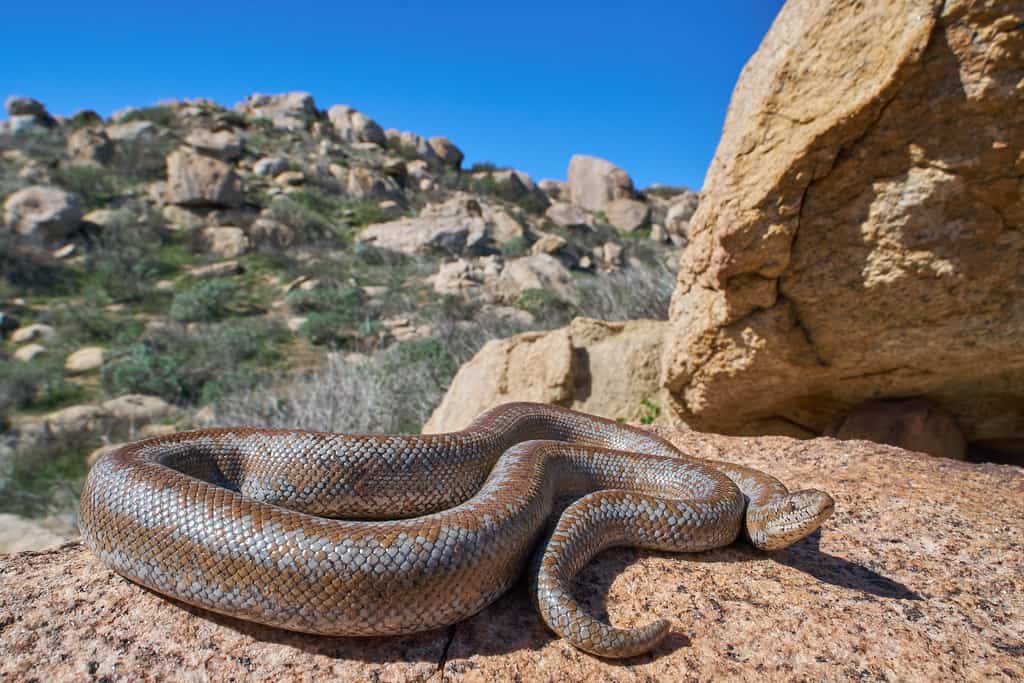
Is a Rosy Boa venomous? No. It kills its prey by constriction.
Where does the Rosy Boa live in Southern California? The Rosy Boa lives in San Diego County, most of Riverside County, the eastern edge of Orange County, northern half of LA County, eastern half of Kern County, and the northeastern corner of Imperial County.
There are two subspecies of Rosy Boar that call Southern California home. Both subspecies are usually between 1.5-3 feet long. The heads are basically the same width as their necks. Rosy Boas have a light base color and three darker stripes along their bodies- one on the top and two on the sides.
The Coastal Rosy Boa lives throughout San Diego County, in the portion of Orange County that borders Riverside County, the western third of Riverside County, southwestern corner of San Bernardino County, and most of the northern half of LA County.
Coastal Rosy Boas are usually a light cream or gray with orange or orangish brown stripes. There are also some unicolor Rosy Boas that tend to be an orangish gray. Their undersides are light with some dark splotches.
This boa is most commonly found in rocky deserts and shrublands, but it is also found in coastal chaparral in San Diego County and show up in the more aris, shrubby hillsides as well.
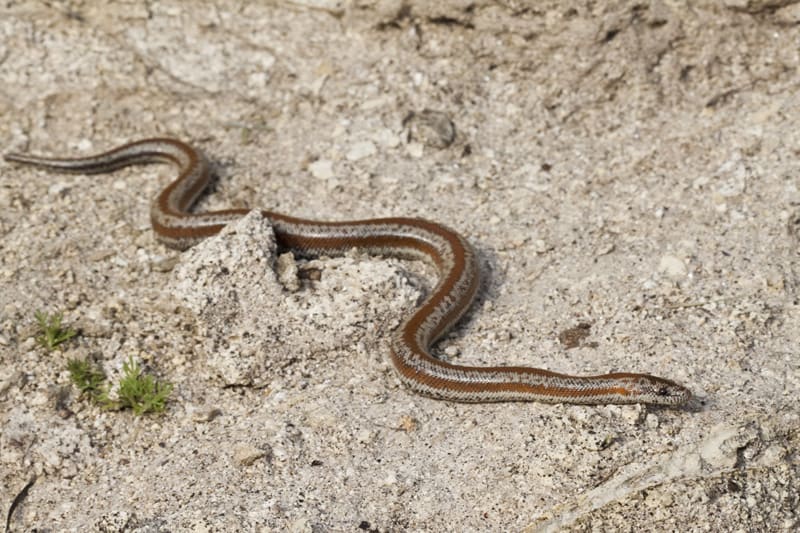
The Desert Rosy Boa lives in the Antelope Valley, most of San Bernardino County, the eastern third of Riverside County, northeastern corner of Imperial County, and its territory spreads into portions of Kern and Inyo County. It prefers rocky desert areas and more shrubby deserts and canyons.
Desert Rosy Boas are light tan or gray with more of a rusty-orange stripe color. Their bellies are typically light and may be spotted.
Both subspecies of Rosy Boa eats mice, kangaroo rats, ground squirrels, and other rodents as well as small reptiles, birds, and amphibians.
Western Yellow-bellied Racer Snake

Is a Western Yellow-bellied Racer venomous? No.
Where does the Western Yellow-bellied Racer live in Southern California? This snake is widely distributed through the coastal counties of Southern California (Santa Barbara, Ventura, Los Angeles, Orange, and San Diego). It can also be found in the southwestern corner of San Bernardino County and the western quarter of Riverside County.
The Western Yellow-bellied Racer (a great name for a snake!) is common throughout most of California, outside of the deserts and high alpine regions.
It hunts during the daytime and lives in most environments where it can find some sunshine like grassland, edges of lakes and streams, chaparral and woodlands that aren’t heavily forested.
This snake is usually under three feet long and olive, bluish gray, or brown on top. It is yellow (not just a clever name!) or off white underneath.
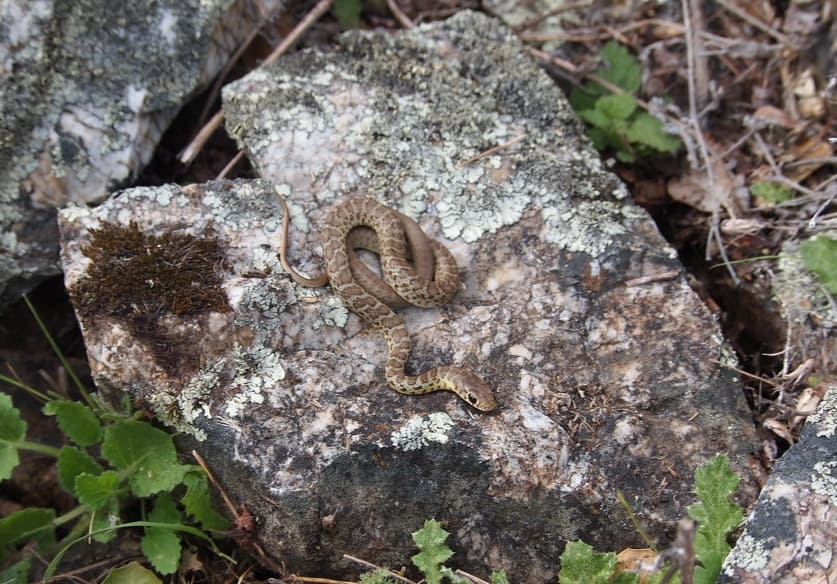
This is one of those snakes that looks drastically different when young. Young Yellow-bellied Racers have dozens of dark splotches all over their backs which make them look like Gopher Snakes, except they don’t have the stripes near their eyes that Gopher Snakes have.
They are good climbers and will climb trees if the opportunity for a meal presents itself, but they mainly stick to the ground.
These little suckers are aggressive and will bite if you don’t give them space. Luckily they aren’t venomous.
When these snakes hunt, they move along the ground with their heads held high. They lunge at their prey and crush it with their jaws, eating the animal alive.
They eat small critters like lizards, small amphibians, birds, eggs, mice,and voles. They will also eat large insects.
California Striped Racer Snake
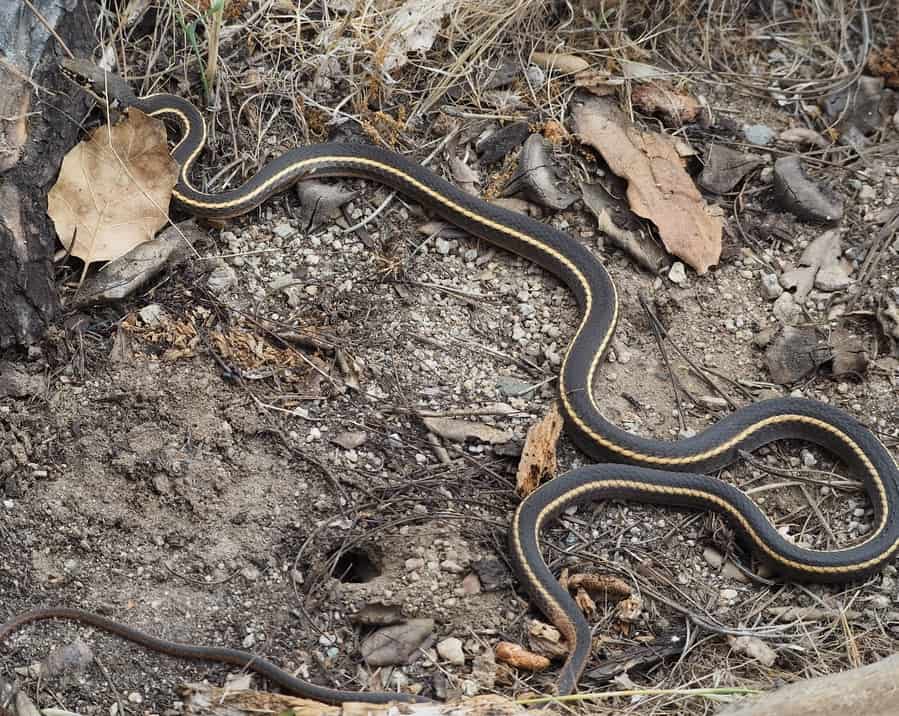
Is a California Striped Racer Snake venomous? No.
Where does the California Striped Racer live in Southern California? This snake is widely distributed through the coastal counties of Southern California- Santa Barbara, Ventura, Los Angeles (minus the Antelop Valley), Orange, and San Diego. It can also be found in the southwestern corner of San Bernardino County and third of Riverside County.
The California Striped Racer is similar to the Western Yellow-bellied Racer. It likes open area with plenty of sun available like chaparral, scrubby or rocky hillsides, water’s edge, and open woodlands.
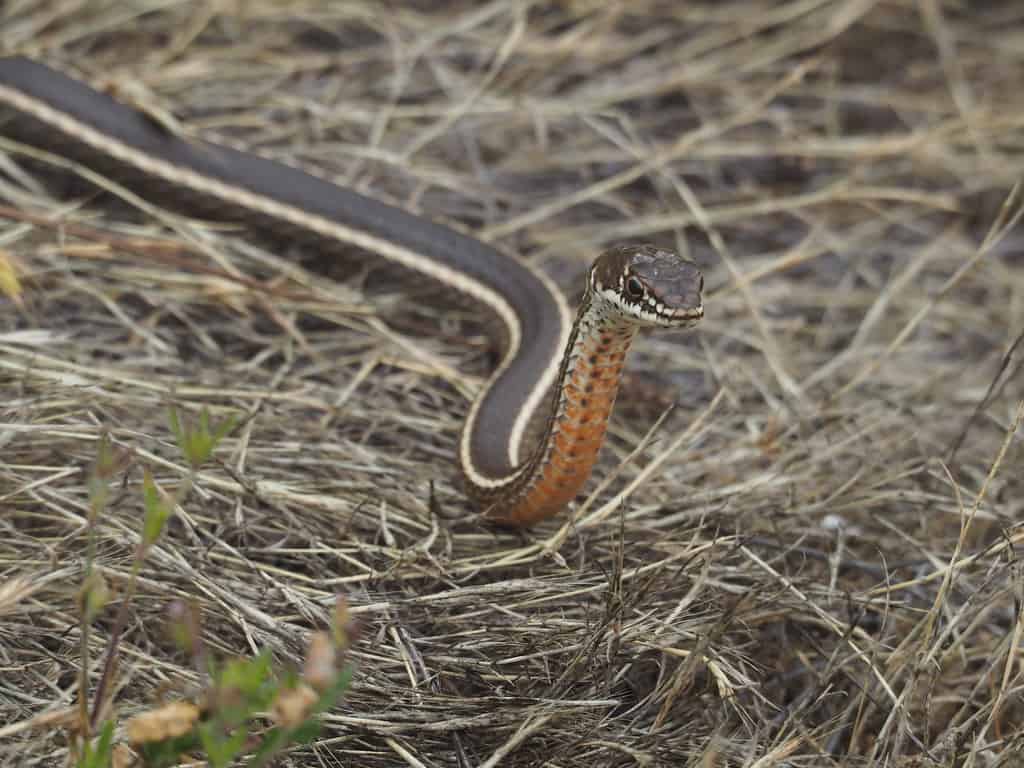
The California Striped Racer (Also known as a Whip Snake) is another snake that is common throughout large portions of California. It is usually 2-5 feet long and in many ways looks similar to a Garter Snake.
It is dark brown to black with two yellow stripes along either side of its body. Remember, Garter Snakes have three stripes? So if you only count two and don’t see a stripe on the mid-back, it is likely a California Striped Racer.
While it is not venomous, the California Striped Racer is agressive and will whip and strike repeatedly if you pick it up.
The California Striped Racer hunts in a similar fashion to the Yellow-bellied Racer with its head up and plenty of speed and great vision. They are also good climbers but mostly stick to land.
It likes to eat lizards (their favorite food) and other small creatures like mice, voles, frogs, small snakes, little birds, and salamandars.
Western Blind Snake
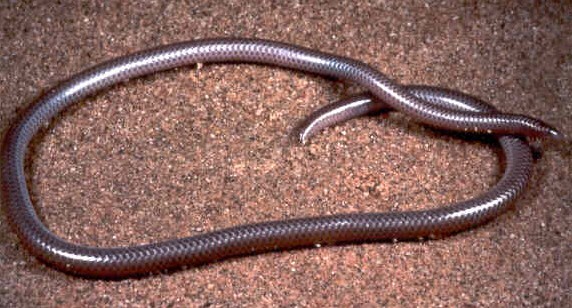
Is the Western Blind Snake venomous? Nope
Where does the Western Blind Snake live in Southern California? This snake is found in every county in Southern California.
Fun Fact: The Western Blind Snake is also commonly referred to as the Western Threadsnake
There are two subspecies of Western Blind Snake in Southern California, the Southwestern Blind Snake and the Desert Blind Snake.
The Southwestern Blind Snake lives in the more coastal regions of Southern California. It calls eastern Santa Barbara County, Ventura County, LA County, Orange County, San Bernardino County, western Riverside County, and most of San Diego County home. Its territory also stretches into Inyo and Kern counties.
Desert Blind Snake is a subspecies of this snake that lives in the southeastern corner of California, mainly in Inyo County, eastern Riverside County, and far eastern San Diego County.

Blind Snakes look a lot like worms. They are only 7-16 inches long when fully grow and very thin. Their heads are the same width as their neck. They even have the typical worm coloring- brown, pinkish, or dark gray.
These snakes are, in fact, blind. They are also nocturnal and hide under rocks or debris during the day. They mainly eat ants and termites and will burrow in the ground to reach them. This behavior also results in people mistaking them for worms.
Since they do burrow for their prey they live in places where burrowing is easy. Sandy places like beaches or deserts. Spots with looser soil like washes and rocky, brushy hillsides.
Red Racer Snake

Is a Red Racer Snake venomous? No
Where does the Red Racer Snake live in Southern California? This snake lives in every county in Southern California wherever the landscape is more desert or coastal scrub.
Another name for the Red Racer Snake is the Red Coachwhip. It is a fairly common snake in Southern California. The Red Racer can get quite big, three to nearly six feet long. Only the Gopher Snake is longer in Southern California.
Red Racers are usually red, pink, tan, or brown with distinctive black bands around their necks. They are typically light pink underneath. Their scales on their long, thin tails look braided like a whip, hence the name “coachwhip”.
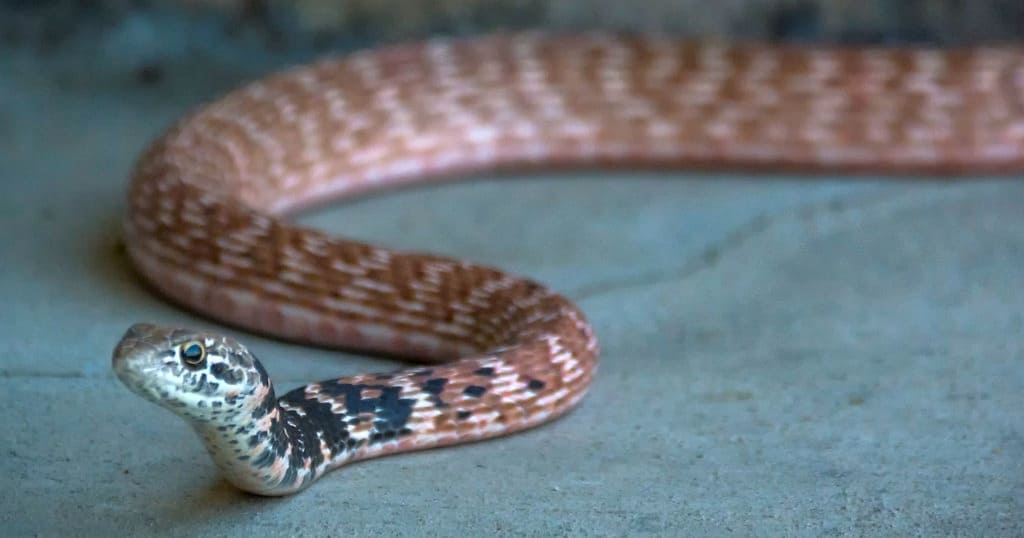
The Red Racer is quick and prefers habitats without dense vegetation that will slow it down. Therefore it lives in more open habitats like sagebrush, chaparral, desert, grasslands, and rocky areas.
It is an active hunter in the daytime, and hides in animal burrows, in brush, or under rocks when it is not out and about. It is good at climbing trees. When hunting, it crawls with its head up high, often swaying side to side.
It has excellent vision and scent, and crushes its prey with its jaws, eating the animal whole. It eats mice, kangaroo rats, lizards, small snakes, amphibians, small birds, eggs, and even bats.
Red Racers are often spotted alongside highways, unfortunately as roadkill. This is partially because they love basking in the heat reflected off the highway and partly because it will eat fresh roadkill.
They are also a more aggressive snake and will bite if threatened or attempted to be handled.
Ring-Necked Snake
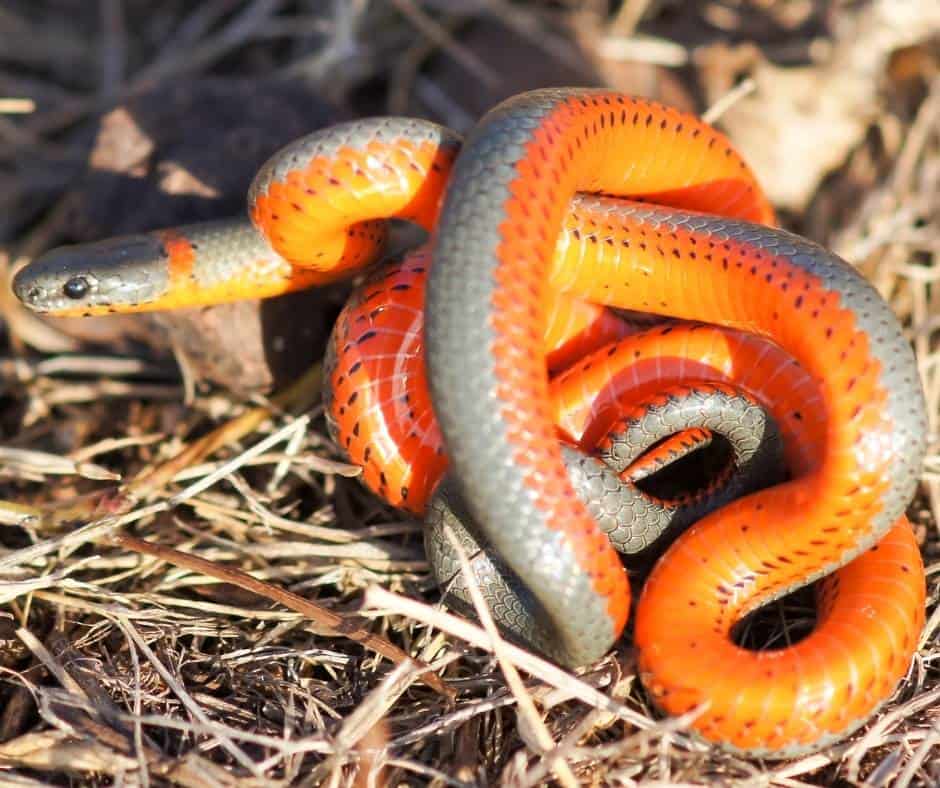
Is a Ring-necked Snake venomous? It is mildly venomous but the venom does not pose a threat to humans.
Where does the Ring-Necked Snake live in Southern California? This snake lives in all the coastal counties of Southern California, as well as the southwestern corner of San Bernardino County and the western third of Riverside County.
There are three subspecies of Ring-necked Snake in Southern California- the San Bernardino Ring-necked Snake, the San Diego Ring-necked Snake, and the Monterey Ring-necked Snake.
The Monterey Ring-necked Snake lives in Santa Barbara County and up the Central Coast.
The San Bernardino Ring-necked Snake can be found in Ventura County, LA County (minus the Antelope Valley), Orange County, the southwestern corner of San Bernardino County and the western third of Riverside County.
The San Diego Ring-necked Snake lives in San Diego County.
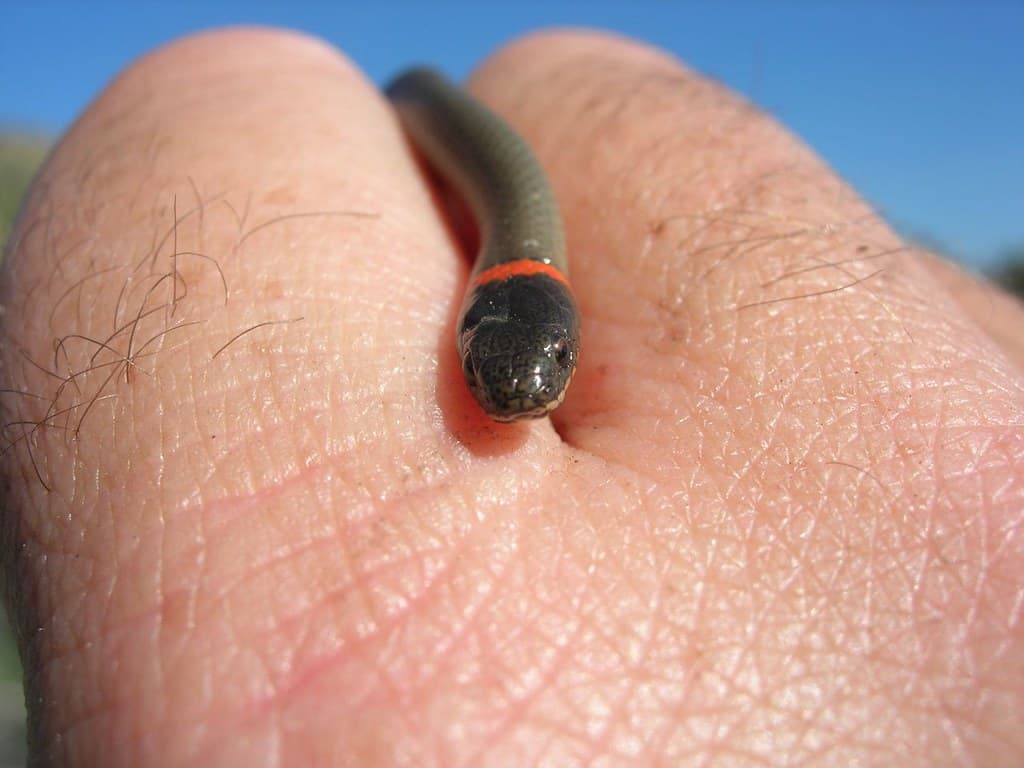
Ring-necked Snakes are small, about pencil width, and 10-16 inches in length. These are shy snakes that generally hide under things like rocks, logs, or leaf litter. You would be most like to see them by lifting up rocks or logs, or around dusk.
They live in moist habitats like woodlands, irrigated farmland, grasslands, riparain areas, or rocky hillsides.
They like to eat amphibians like salamanders, small frogs, and tadpoles. They will also eat slugs, worms, and tiny snakes and lizards.
They tend to be shades of gray, from olive to charcoal, and have a distinctive orange or yellow band on the back of their necks. They are bright orange underneath, and will flip their tail up to show you their underside if they feel threatened.
Glossy Snake
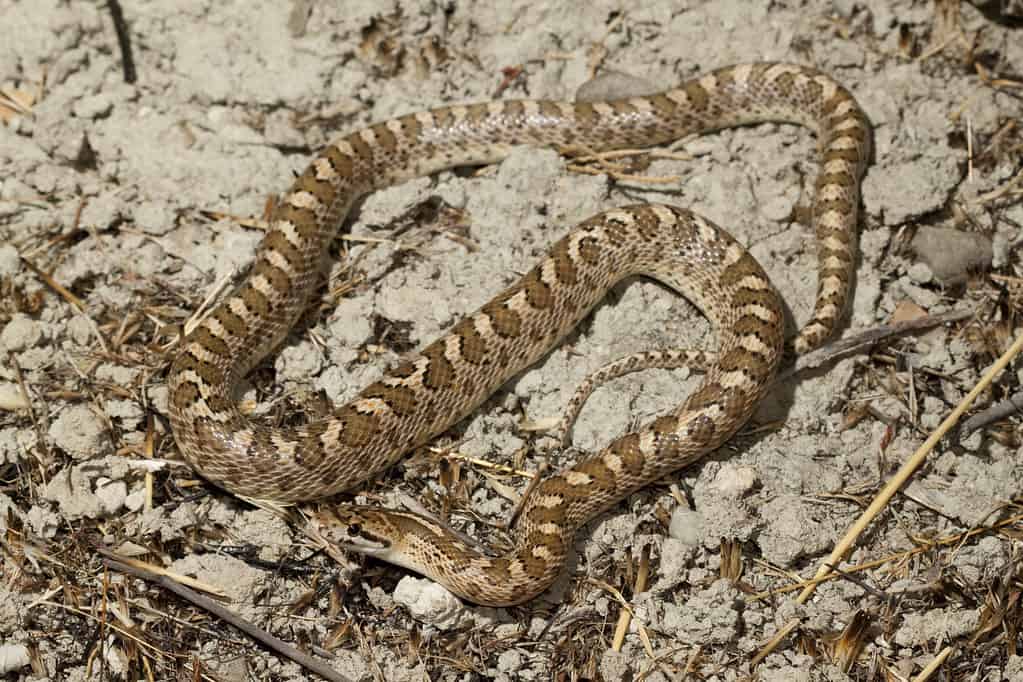
Is a Glossy Snake vemomous? No
Where does the Glossy Snake live in Southern California? The Glossy Snake lives in Ventura, LA, Orange, San Diego, Imperial, Riverside, and San Bernardino counties.
Glossy Snakes are often confused with Gopher Snakes because they do look similar. The scales are glossy, hence the name, but the coloring does look a bit faded or bleached out. For this reason it is also commonly referred to as a “faded snake”.
They are smaller than Gopher Snakes and are generally 3-4 feet long when fully grown. Their heads are also narrower than a Gopher Snake’s.
There are three subspecies of glossy snake that live in Southern California- the California Glossy Snake, the Desert Glossy Snake, and the the Mojave Glossy Snake.
The California Glossy Snake lives in southern Ventura County (as well as the very top edge of the county), most of LA County (outside of the Antelope Valley), Orange County, San Diego County, the southwestern corner of San Bernardino County, and the west quarter of Riverside County.
It is usually a big darker than the other subspecies of Glossy Snakes. The base color is tan to brown with dark brown splotches (outlined in black) that are almost rectangular on its mid back and smaller splothes running along either side of its body. The underside is pale.
They live in chaparral, grasslands, and washes where it is easy to burrow in the sand.
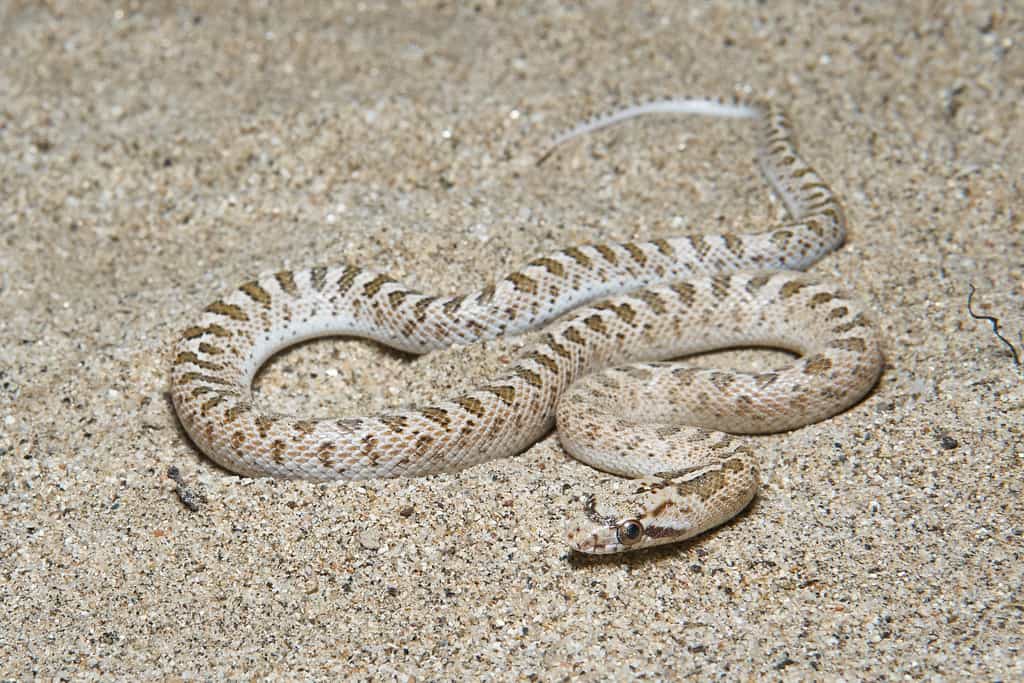
The Desert Glossy Snake lives in the very eastern edge of San Diego County, Imperial County, the eastern 3/4 of Riverside County, and the lower 2/3 of San Bernardino County.
It is generally more pale in color than the other two subpecies of Glossy Snake in Southern California. It’s base color is a light sand and it has the rectangularish splotches outlined in black down its mid back with smaller splotches running along either side of its body and the pale underside.
It lives in desert habitats, especially where it is particularly sandy or scrubby.
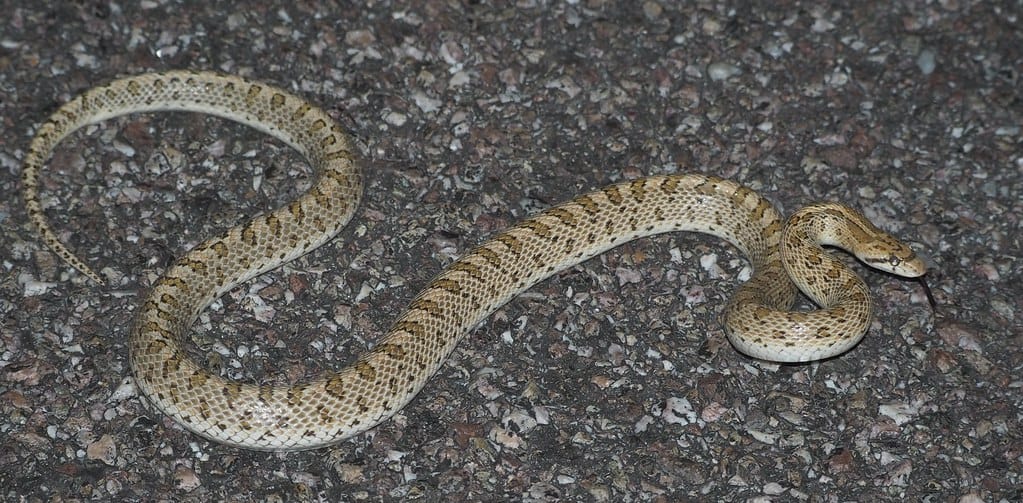
The Mojave Glossy Snake is native to the Mojave Desert including the Antelope Valley, and the upper third of San Bernardino County. Its territory extends into Kern and Inyo counties.
This snake’s base color ranges from cream to tan to light brown. The splotches are typically a mustardy brown to gray with black outlines. They are pale underneath.
These snakes are nocturnal. They hunt at night. During the day they sleep in animal burrows or under rocks. They can also make their own burrows using their specialized nose. They live in the desert (especially in sand or scrub) as well as grasslands in their range.
Glossy Snakes eat mostly lizards, but they will also eat small mammals that are nocturnal, birds that live primarily on the ground, and even small snakes. They are ambush predators who kill their prey by either constriction or just swalling them alive.
Shovel-nosed Snake
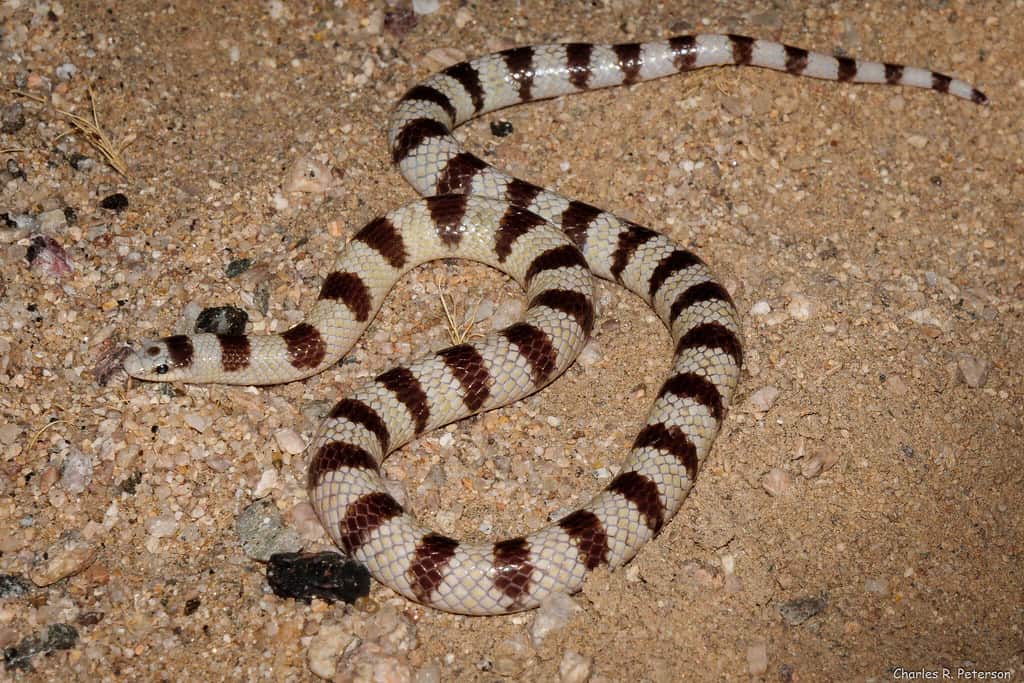
Is a Shovel-nosed Snake venomous? No
Where does the Shovel-nosed Snake live in Southern California? These are desert dwellers foound in the Mojave and Colorado deserts of Southern California. These cute little guys are only a foot to a 18 inches long when fully grown.
The Shovel-nosed Snake uses its flat, slightly pointed snout to “swim” through desert sand. It is nocturnal so your best chances of seeing them are when they cross desert roads at night. They live in sandy desert areas, desert washes, or portions of the desert with few plants.
There are two subspecies of Shovel-nosed Snake that live in Southern California, the Mojave Shovel-nosed Snake and the Colorado Desert Shovel-nosed Snake.
The Mojave Shovel-nosed Snake lives in the Antelope Valley of LA County, most of San Bernardino County (outside of the southwestern corner), and the eastern two thirds of Riverside County. Its territory extends into the desert regions of Kern and Inyo counties as well.
This subspecies has a cream or light yellow body with dark brown bands going around most of its body. The bands don’t fully connect on their undersides.
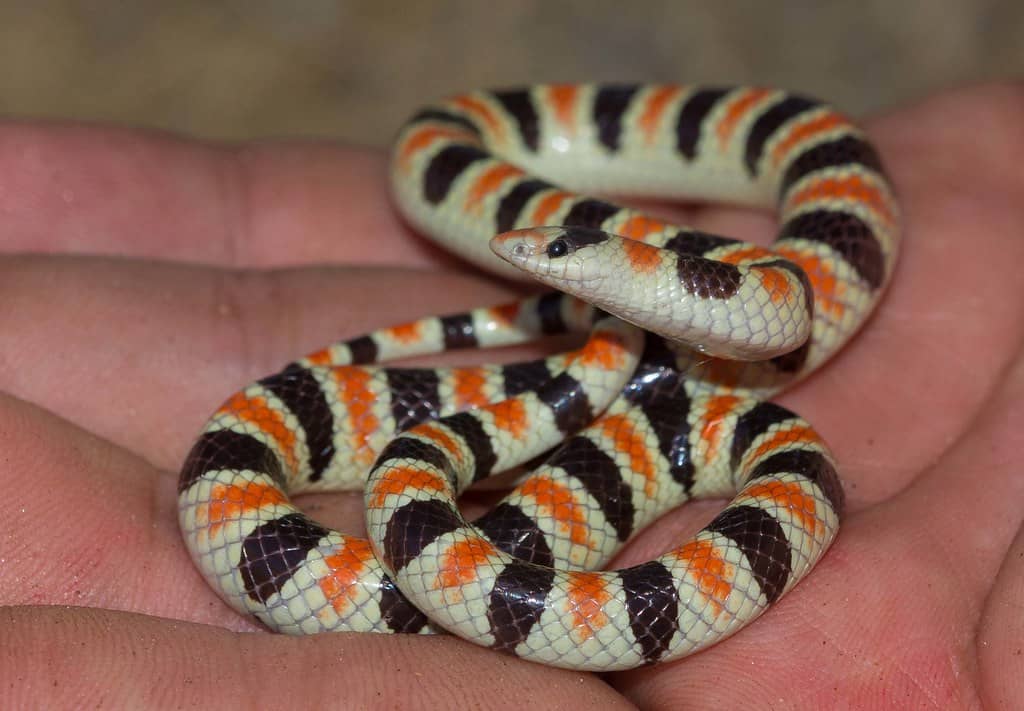
The Colorado Desert Shovel-nosed Snake lives in Imperial County as well the far northeastern corner of San Diego County.
This subspecies also has a cream or light yellow body but the bands going around its body are black with thin red crossbands in between. Some of their black bands do completely encircle the body but the red ones do not. There are some varieties where the red is barely there.
Both subspecies of Shovel-nosed Snakes in Southern California eat insects, spiders, scorpions, and centipedes.
Spotted Leaf-nosed Snake
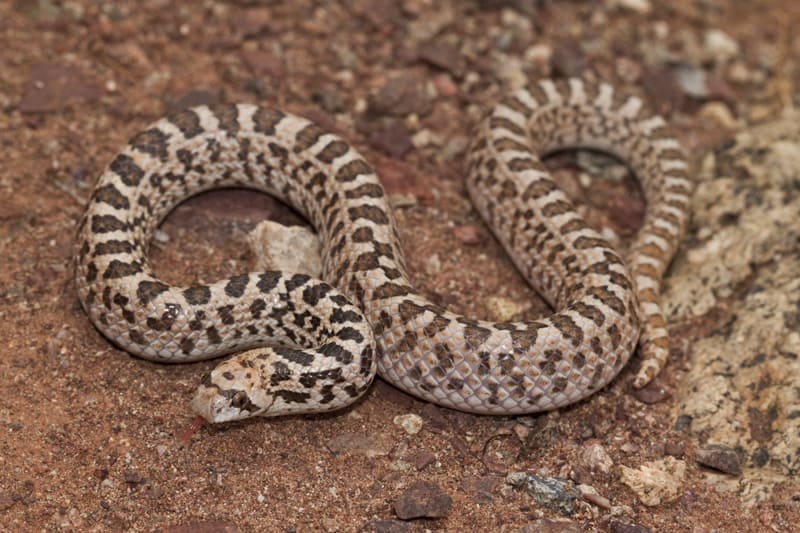
Is a Spotted Leaf-nosed Snake venomous? No
Where does the Spotted Leaf-nosed Snake live in Southern California? This snake is a desert dweller found in Inyo County, the eastern border of San Diego County, the eastern 2/3 of Riverside County, most of San Bernardino County other than the southwestern corner, the Antelope Valley. Its territory does stretch into portions of Kern and Inyo counties.
The Spotted Leaf-nosed Snake is a small snake (12-20 inches) that lives in rocks and sandy desert areas like washes or foothills below 3,000 feet. There are typically creosote bushes nearby which provide some cover.
They are nocturnal and generally pretty secretive, so sightings are not common. Sightings are most likely to occur in the spring and summer. They use the leaf on their nose to burrow in the sand. They eat lizards, especially Western Banded Geckos.
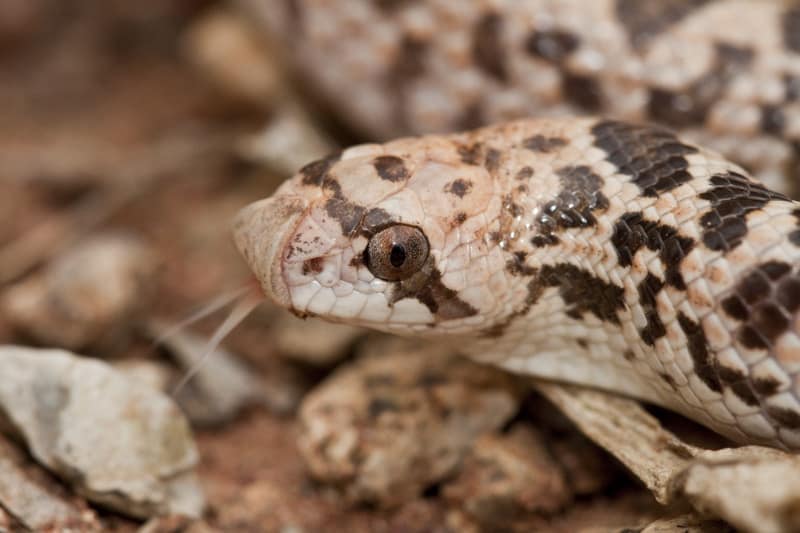
This is generally tan to an almost grayish color with small, irregular shaped dark spots all over their backs. Their bellies are very light. Their noses look almost like shovels with one large scale folded over. They are called Leaf-nosed Snakes because it is said to also look like a portion of a leaf folded over.
Another unusual feature of this snake is that its pupils are vertical. Though, it has been noted that when flash photos are take of this snake at night the pupils appear more round.
Long-nosed Snake
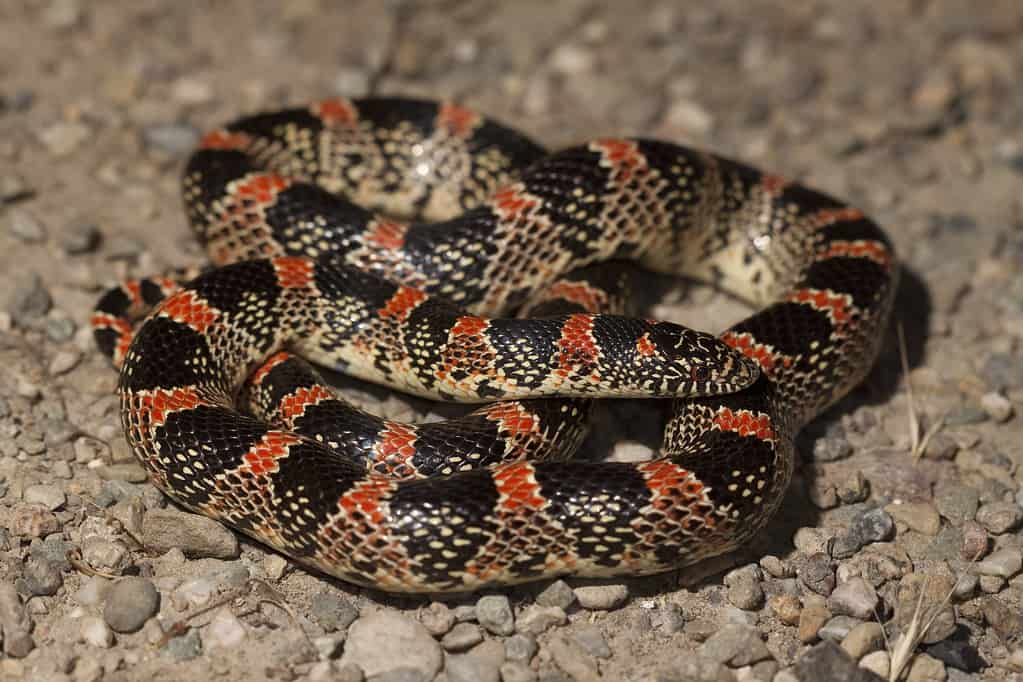
Is a Long-nosed Snake venomous? No
Where does the Long-nosed Snake live in Southern California? The northern half of LA County, eastern edge of Orange County, and nearly all of Inyo, San Bernardino, Riverside, Imperial, and San Diego counties. The territory extends into Kern County and up the Central Valley.
The Long-nosed Snake lives in grasslands, deserts, and shrubby areas. It is a nocturnal snake that is generally lives most of its life burrowed underground. You are most likely to see it along roads at night.

This is a thin snake with a head about the same width as its body. It has a long, pointed snout and bit of an overbite. These snakes are usually between 18 inches and three feet long when fully grown.
They are beautiful snakes with a cream colored body and alternating red and black speckled banding. The speckles in the banding are the cream color of the body. The underside of this snake is a solid cream.
While this snake is not aggressive and generally pretty shy, it does have a very unusual defense mechanism when handled. It will empty the contents of its cloaca (which non-venomous snakes like Garter Snakes are apt to do) along with an amount of blood that it will smear all over its body!
The long-nose snake eats mostly lizards and amphibians as well as small snakes. It will eat rodents on rare occasions when their other favorite snacks aren’t readily available. They kill their prey via constriction.
Patch-nosed Snake

Is a Patch-nosed Snake venomous? No
Where does the Patch-nosed Snake live in Southern California? The Patch-nose Snake lives in every county in Southern California.
Three subspecies in Southern California- the Desert Patch-nosed Snake, the Coast Patch-nosed Snake, and the Mojave Patch-nosed Snake.
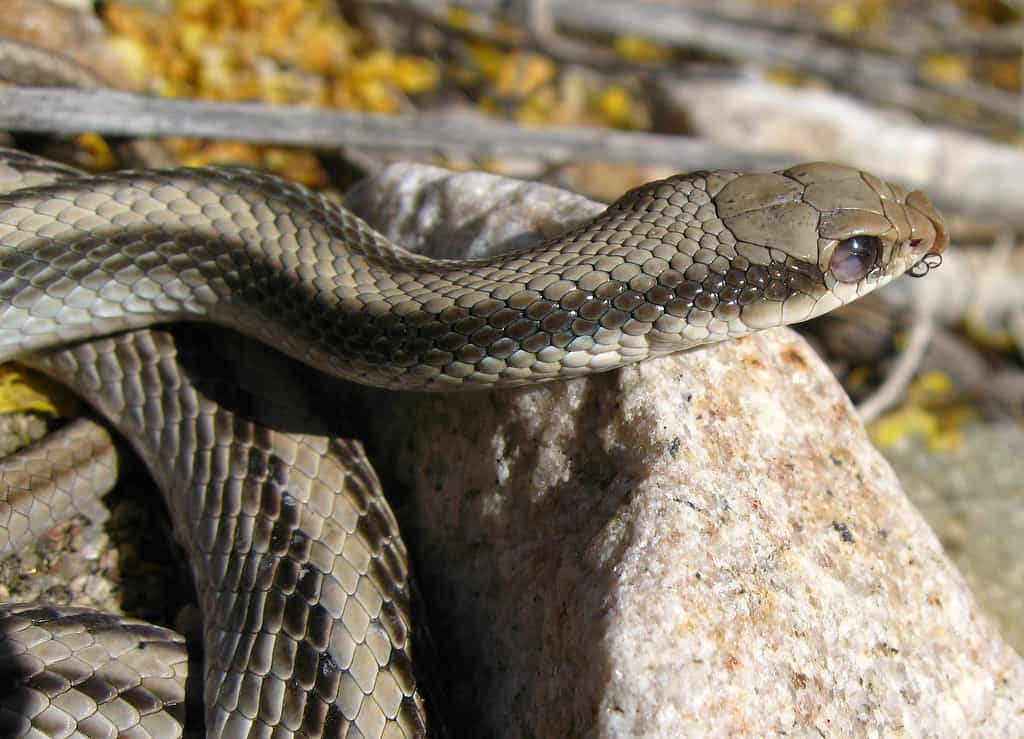
The Desert Patch-nosed Snake lives in the eastern 2/3 of Riverside County, Imperial County, and the eastern edge of San Diego County. It lives mainly in the desert, as well as rocky hillsides and scrubby areas.
This snake is pale gray to a lighter gray-brown on its sides with a yellow or tan stripe down the middle of its back. Its head is close to the shade of its side color. It is usually light yellow underneath.

The Coast Patch-nosed Snake lives in all the coastal counties of Southern California, though is is not spotted in the more heavily populated LA Basin, Antelope Valley, and north Orange County areas. It lives in chaparral, scrubby areas, and rocky hillsides.
These snakes are dark gray to brown on their sides with a lighter, tan to yellow stripe going down the middle of the their backs. Their undersides and bottom flanks are the same color as the strip on the top of their back. Their heads are a shade of brown.
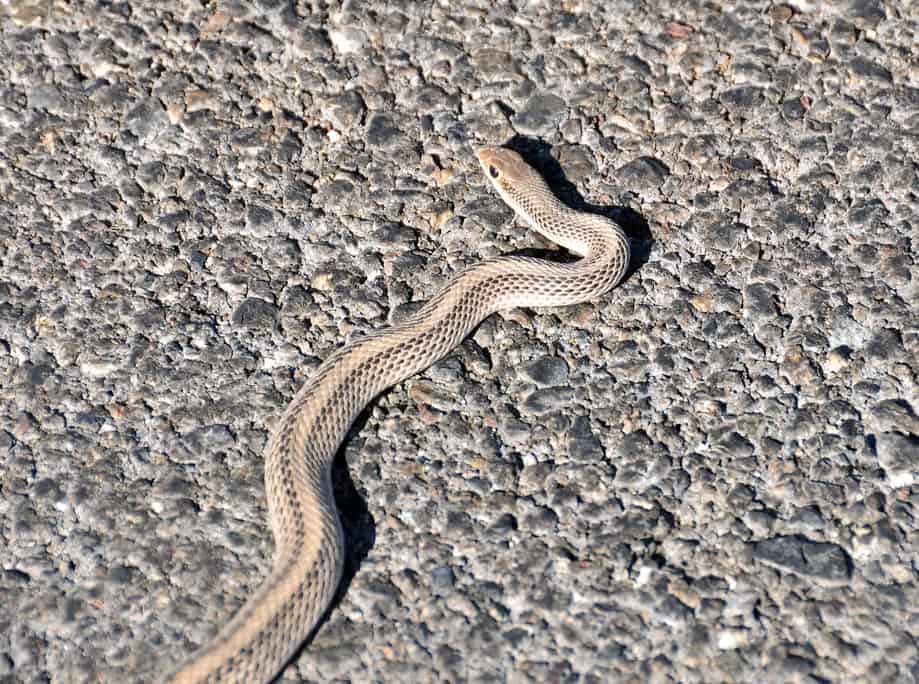
The Mojave Patch-nosed Snake is another desert dweller. It lives in the Antelope Valley, all but the southwestern corner of San Bernardino County, Inyo County, and portions of Kern County. In addition to desert it will also live in rocky hillsides and canyons, and some sagebrush habitat.
This subspecies is light gray with a wide, tan or yellow stripe down the middle of its back and darker gray to black stripes on either side of the wide stripe. The tops of their heads are gray to brownish gray. They are pale underneath.
The Patch-nosed Snake is typically 2-3 feet long. It primarily eats lizards but it will eat rodents and smalll rabbits as well. This snake is an active hunter during the day. This snake does not constrict its prey, it throws loops of its body on top of the prey to subdue it.
This snake is named for the patch-like rostral scale on the end of its nose. It can use that nose to burrow and seek out treats like reptile eggs.
Since very little is known about this snake (which is considered a species of special concern) and no scientific publications have been written about it, the San Diego Safari Park is currently engaging in a study of the Coast Patch-nosed Snake which is endemic to this park’s land. They are tracking 20 adult snakes with radio transmitters to better study these snakes.
Desert Striped Whipsnake
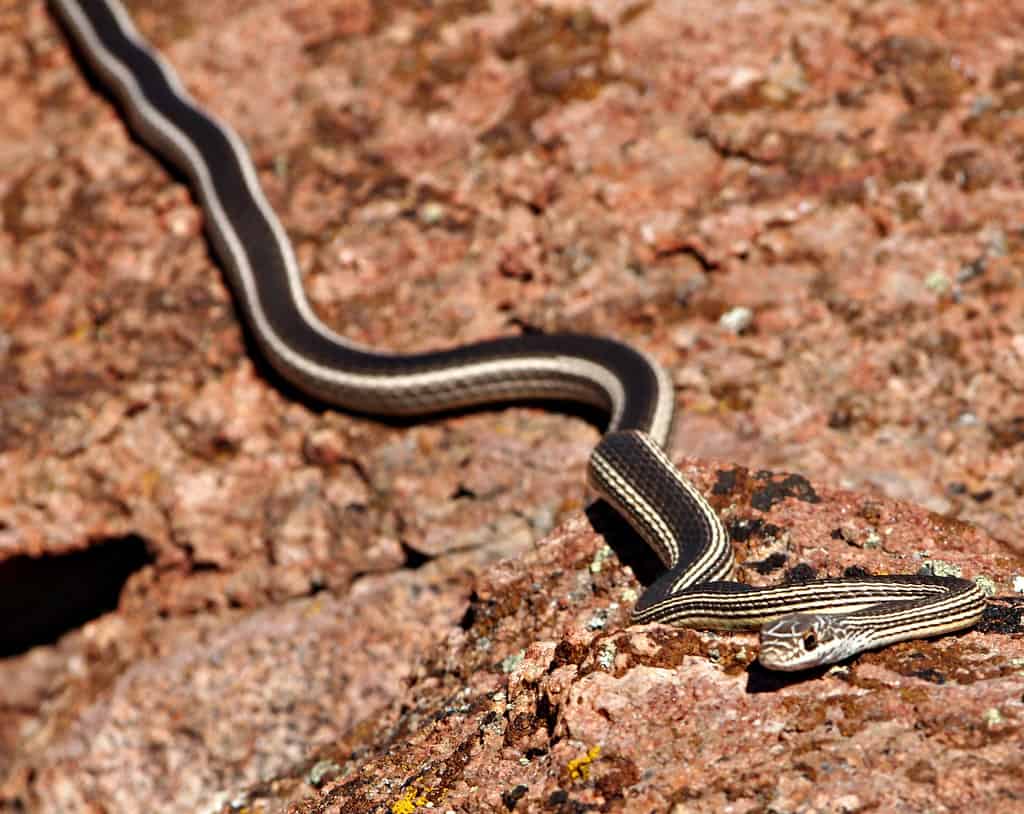
Is a Desert Striped Whipsnake venomous? No
Where does the Desert Striped Whipsnake live in Southern California? The northern portions of San Bernardino County into Inyo County.
The Desert Striped Whipsnake lives in the rural desert scrub and sagebrush flats of some of the most unpopulated areas in California.
It is a fast moving snake and hard to photograph and identify because it doesn’t stick around long enough. It can be spotted near the rare river or pond that is located in this especially dry part of the state.
When the Desert Striped Whipsnake hunts during the day, it slinks around with its head off the ground and uses its vision to identify prey- lizards, snakes, amphibians, birds, and small mammals- basically whatever is around.
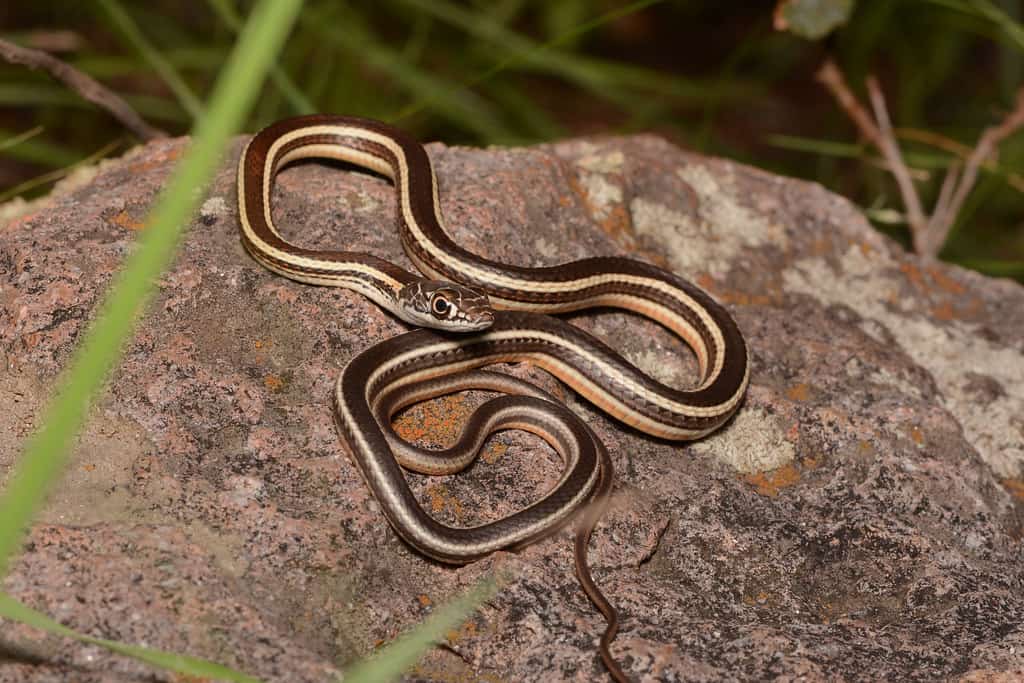
It is a slender but long snake, ranging in length from 2-5 feet. It is dark gray (sometimes more olive or black) in color with cream/light yellow stripes running down the side of its body. Its head is usually dark gray to olive brown and is slightly wider than its neck. Its undernath is usually cream but can get quite pink as it gets closer to the tail.
It is closely related to the Striped Racer that is common to the coastal counties of Southern California. It will try to bite you if you get your hands on it.
Western Black-Headed Snake
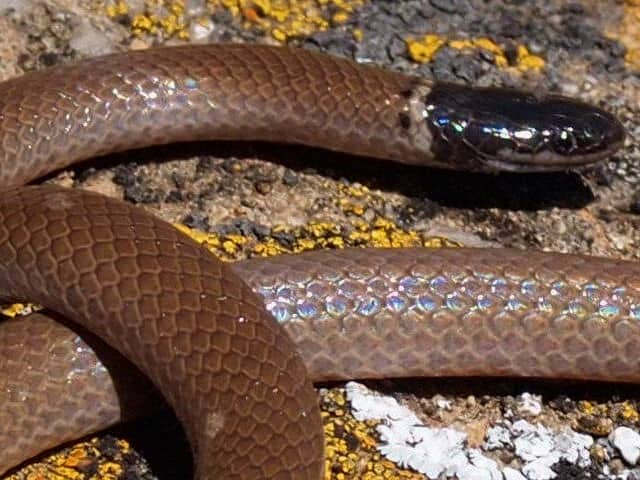
Is the Western Black-headed Snake venomous? It is mildly venomous but the venom is not dangerous to humans.
Where does the Western Black-headed Snake live in Southern California? In Southern California’s coastal counties as well as the eastern third of Riverside County and the southwestern corner of San Bernardino County as well as the southwestern corner of Imperial County.
The Western Black-headed Snake (also known as the California Black-headed Snake) is one of the smallest and most reclusive snakes in Southern California. This little guy is only 4-16 inches long when fully grown and quite slender.

It is a burrower with a flat head, and spends most of its life under objects or underground. Your best chance to spot them is at night after a rainfall or lifting up a rock and getting lucky. It eats insects, centipedes, and millipedes.
It can live in a variety of habitats such as chaparral, deserts, washes, grassy hillsides, and along the edges of waterways.
It has brown or tan body and a dark gray/black head with a white ring in between the head and body. The underside is usually reddish.
Variable Ground Snake
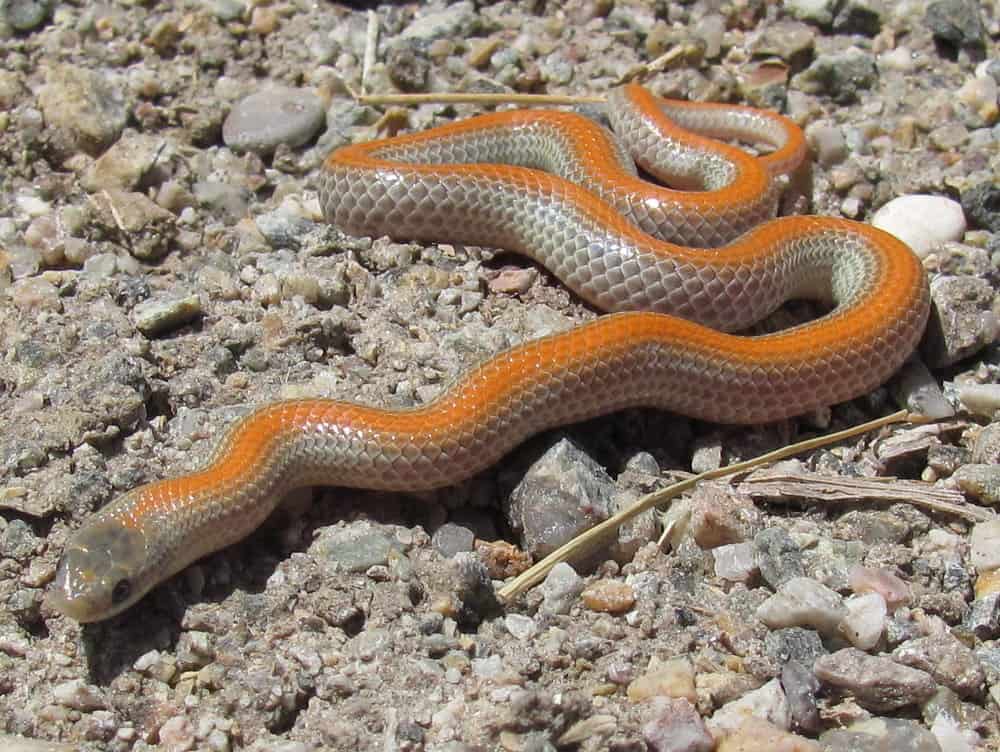
Is a Variable Ground Snake venomous to humans? No
Where does the Variable Ground Snake live in Southern California? Eastern 3/4 of Imperial County, eastern half of Riverside County, all of San Bernardino County except the southwestern corner, and on into Inyo County.
Though this little snake inhabits some of the driest portions of the state, it does live in areas that receive more moisture than the surrounding environment like washes and dry river bottoms. Overall it likes dry rocky areas with loose soil.
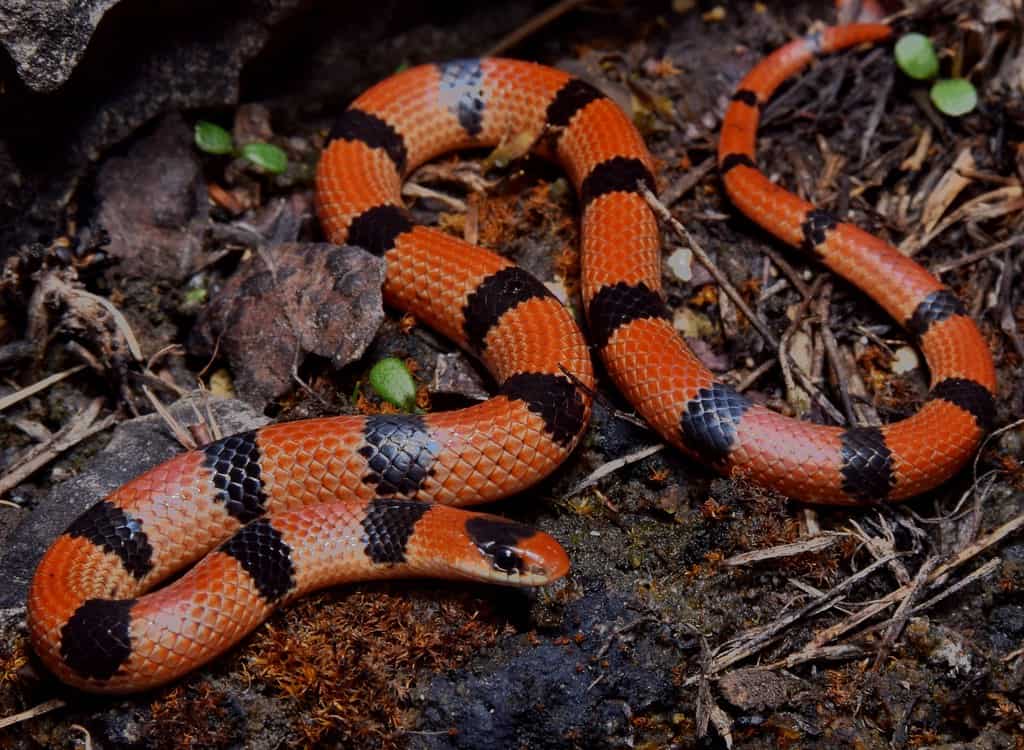
The Variable Ground Snake is only 8-12 inches in size with smooth, shiny scales that comes in variable colors and patterns (hence the name). The have small heads and big pupils.
Their base color can be gray, light brown, orange, or red. They can be red banded, black banded or black and red banded. Or they could have no bands at all and be a solid brown color on top. They can even be orange with gray sides. Their underside is usually white and may or may not have some black bands near the tail.
Variable Ground Snakes are nocturnal and shy, but quite common. You will most llikely spot one in a wash or along the road at night, looking for food. They eat insects, spiders, larvae, scorpions, and centipedes.
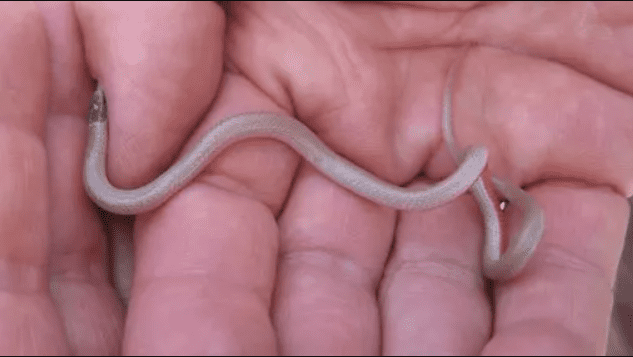
There is another subspecies, known as the Smith’s Black-headed Snake, that is found in spotty locations of the Southern California desert such as Death Valley and Joshua Tree. It is quiet small and thin, only 5-15 inches long.
The body is usually brown or tan with a dark head. The underside is red. It looks similar to the Western Black-headed Snake but doesn’t have the white ring on its neck.
Nightsnake

Is a Nightsnake venomous? They are mildly venomous but the venom is not dangerous to humans.
Where does the Nightsnake live in Southern California? The nightsnake is widely seen in every county in Southern California.
There are three subspecies of the Nightsnake in Southern California, the California Nightsnake the Desert Nightsnake and the San Diego Nightsnake.

The California Nightsnake lives in northern Santa Barbara County and points north.
The Desert Nightsnake is in the desert areas of the region- the eastern edge of San Diego County, Imperial County, eastern 2/3 of Riverside County, all but the southwest corner of San Bernardino, and Antelope Valley. Their territory stretches up into Inyo and Kern counties as well.
The San Diego Nightsnake lives in the more coastal areas- southern Santa Barbara County, Ventura County, LA County (minus Antelope Valley), Orange County, most of San Diego County, the eastern third of Riverside County, and the southwest corner of San Bernardino County.
These little guys can look like rattlesnakes in a lot of ways but they are much smaller (10-16 inches), don’t have rattles, and are nocturnal. They also have flat, triangular heads. They are technically venomous but nothing for a human or a large animal to worry about.
Nightsnakes can also be mistaken for Gopher Snakes but again, they are much smaller. Also they have vertical pupils whereas the Gopher Snake has round pupils.
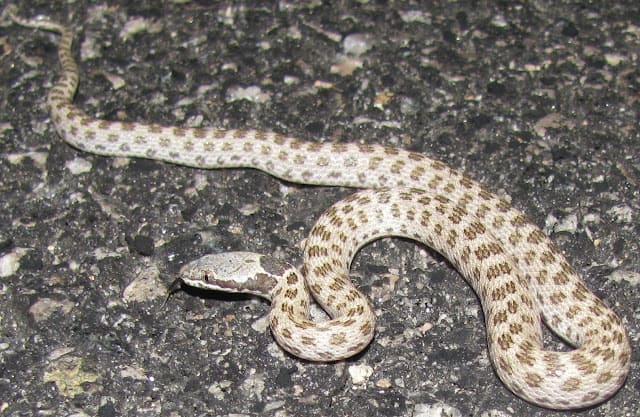
Their base color tends to match their environment which is usually anywhere for cream to light brown or gray. They have big brown or gray splotches down their backs and small splotches on their sides. They have bigger, darker blotches on their necks and their heads match their base color. They are light underneath.
They are common to chaparral and deserts, grasslands and sagebrush, and even backyards! They like to hide under rocks or pieces of wood during the day. At night they hunt for lizards, frogs, salamanders, and small mice. They inject their mild venom by chewing.
Lyre Snake
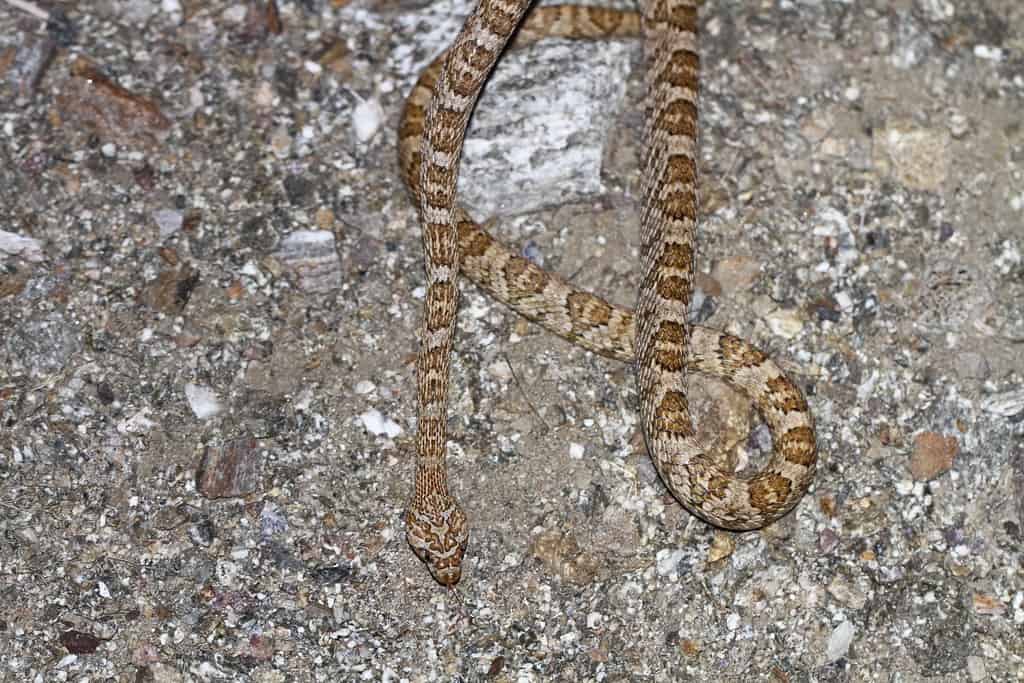
Is the Lyresnake venomous? It does produce a mild venom but it is not harmful to humans or large animals. It may cause some irritation but isn’t truly dangerous.
Where does the Lyre Snake live in Southern California? It lives in Ventura County, eastern LA County, the edges (eastern and western) of San Bernardino County, most of Riverside and San Diego counties, and the northeastern side of Imperial County.
There are two species of Lyre Snake that call Southern California home. The California Lyre Snake is by far the most common.
It lives in most of Ventura County, the eastern half of LA County (other than the far northeastern corner aka: Antelope Valley), scattered portions of San Bernardino County (mostly to the west), most of the western 3/4 of Riverside County, nearly all of San Diego County, and small portions of Imperial County near the San Diego County and the northeastern border with Riverside County.
The Sonoran Lyre Snake lives in far eastern San Berardino, Riverside, and Imperial counties.
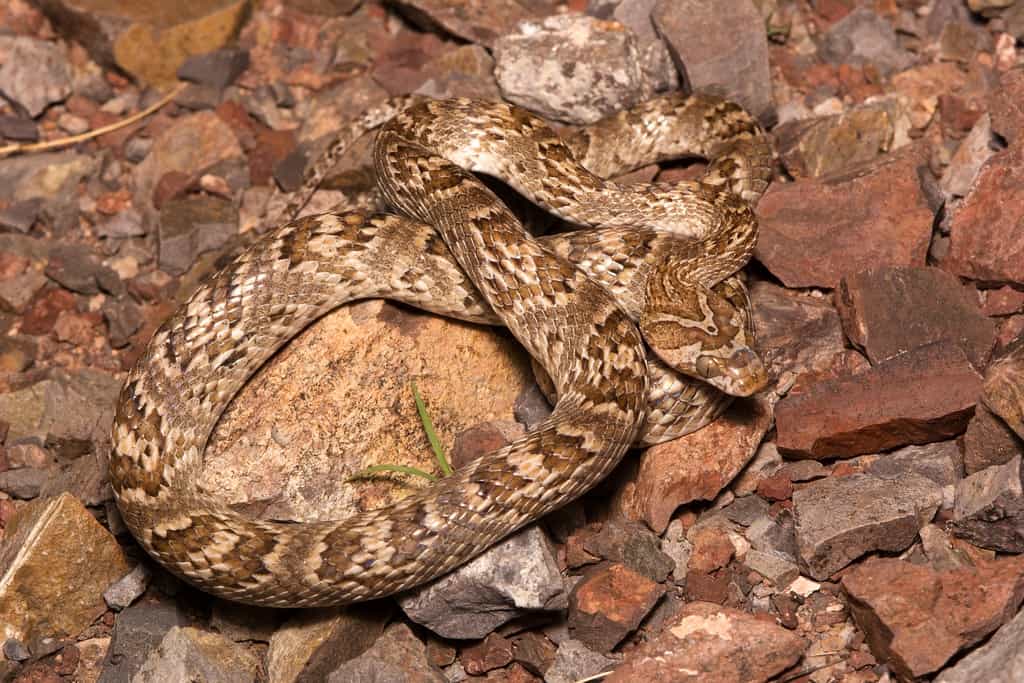
These snakes generally live in rocky areas like deserts and chaparral hillsides. Their coloration makes for excellent camouflage in rocky habitats and they are good at climbing in and around the rocks. This snake is usually 2-3 feet long.
The color of these snakes’ bodies usually matches the rocks of their habitat, typically in shades of tan or brown. They have large, irregular shaped splotches on their backs and smaller version of those splotches on their sides. The splotches are darker than the body, typically dark brown to almost and orangish brown.
They have a v-shaped marking on the top of their heads, aka: a lyre. Their undersides are cream or yellow with scattered brown spots. The pupils of the Lyre Snake are vertical.
The Sonoran Lyre Snake has fewer splotches than California Lyre Snake and their splotches tend to be further spaced apart.
Lyre Snakes are nocturnal and mostly eat lizards, but they will also eat small snakes and mammals. They will also eat birds and bats. The tend to camouflage themselves in the rock and sneak up on the lizards.

